Best down-country mountain bike: short travel shredders
- Danny Milner
- January 10, 2024
Short on travel but big on geometry, we review the best down-country mountain bike rigs – fleet-footed steeds that blend the speed of an XC bike with the capability of trail bike.

Trek Top Fuel 8 Credit: Roo Fowler
Short on travel, light on weight, but big on geometry, the best down-country mountain bike rippers give you everything you want and nothing you don’t. Fast and fun, in a lightweight, efficient package, these bikes can cover ground with minimal fuss and still be thrashed to within an inch of their lives on proper trails.
- Best mountain bikes: hardtail, XC, trail and enduro to suit all budgets
- Best cross-country XC mountain bikes
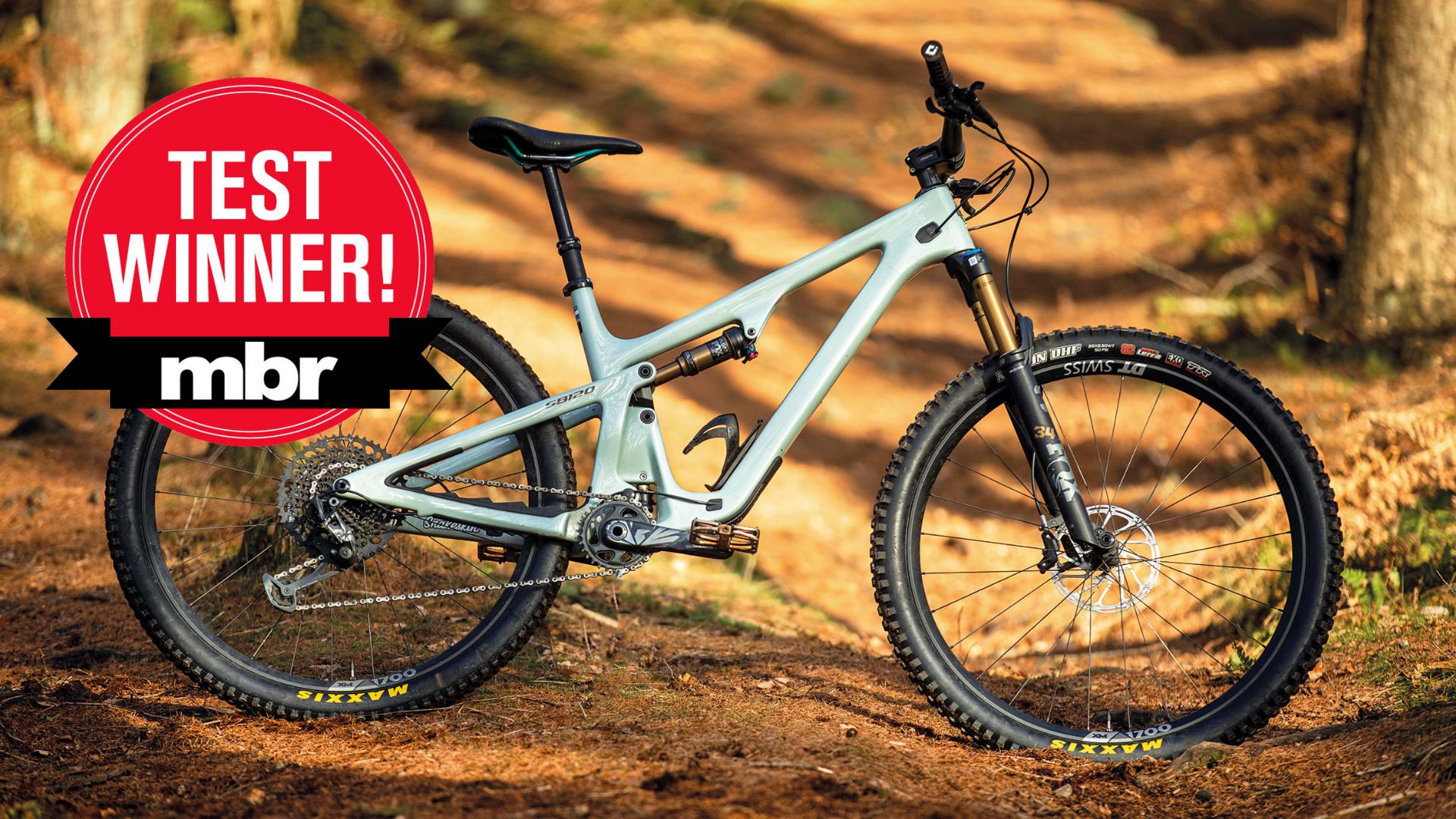
The Yeti SB120 is a down-country bike you can buy with your head as well as your heart

1. Yeti SB120
The best down-country bike if money is no object.
Wheel size: 29in | Frame: Turq carbon, 120mm | Sizes: XS, S, M, L, XL | Weight: 13.3kg (29.3lb) | Rating: 9/10
Reasons to buy:
- All round overachiever with superlative suspension
- Wide size range
Reasons to avoid:
- Agile rather than ultra aggressive
- Not actually that light
- No internal storage
From one of the most aspirational brands in the business comes the impeccable SB120. Yeti shrinks and shoehorns its unique Switch Infinity suspension design into the SB120 chassis. Where the swingarm moves up and down on dual Fox shafts just above the bottom bracket. And the new design has improved seals, bearings, hardware, and pivots, so it should stay in tip-top condition for longer.
And this clever suspension design really works. As we explained in our review, “the supple suspension is stable under power gives a really positive pedalling feel”. Then, when you really hit a something hard and the rear wheel sticks to the ground, giving superb traction and control. It needs a lighter set of wheels to do the flickable geometry and sublime suspension justice, but even out of the box the Yeti SB120 had us smitten.
Read our full review of the Yeti SB120

Santa Cruz’s Tallboy is a terrier that thinks it’s a rottweiler
2. Santa Cruz Tallboy
Best down-country bike for sending it.
Wheel size: 29in | Frame: Carbon CC, 120mm | Sizes: XS, S, M, L, XL, XXL | Weight: 13.08kg (28.84lb) | Rating: 9/10
- Outstandingly fast and focused full-send aggression
- Does things normally reserved for burlier bikes
- Superb size range
- Internal storage compartment
- Needs a pretty skilled rider to avoid pratfalls
- Uncomfortably uncooperative on technical off-piste trails
- Can be tiring to ride
Although often overlooked in the comprehensive, verging on confusing, Santa Cruz range, we think the Tallboy is an undiscovered gem. You’ve heard of small man syndrome, or small dog syndrome, well the Tallboy has small bike syndrome, where it steadfastly believes it’s actually an enduro bike, and deserves to be ridden as such. The stiff frame and aggressive angles beg to be wrung out on every descent, yet the efficient suspension and lightweight mean it’s always the first bike back up to the top of the hill.
For some riders, all that straining at the leash might be too much. But if you love wringing the neck of a short travel whip, and seeing your buddies slack-jawed in amazement as you undermine and overtake their big-travel enduro bikes, the Tallboy is the ultimate sleeper bike.
Read our full review of the Santa Cruz Tallboy

Transition’s Spur is still one of the finest down-country bikes we’ve ever tested
3. Transition Spur
Best lightweight down-country bike.
Wheel size: 29in | Frame: Carbon, 120mm travel | Sizes: S, M, L, XL | Weight: 11.25kg (24.8lb) | Rating: 10/10
- Perfect blend of speed and control
- Lightweight
- Not the most robust build if you’re carrying some timber
- Narrow size range
The Transition Spur is arguably the bike that spawned the down-country category, and also the bike that perhaps best defines it. At under 11.5kg, the Spur flies out of the gate, haring up climbs and tearing along high-speed singletrack. That lack of inertia encouraged us to sprint every rise, pop every jump, and schralp every turn, helped by the stable geometry and supple suspension.
With lightweight RockShox Sid forks up front, the temptation is to add travel and girth, but to do so is to dilute the Spur’s potency and add unnecessary grams. So while there’s a bit of flex when pushed hard, we’d treat that as part of the charm, and lap up the whirlwind of action that accompanies every descent. As we said in our review, the Transition Spur is “the best-realised ‘down-country’ bike we’ve ever tested and the one we all covet if we were spending our own cash”.
Read our full test review of the Transition Spur

Trek’s Top Fuel 8 offers a high-octane ride
6. Trek Top Fuel
Explosive trail weapon.
Wheel size: 29in | Frame: Carbon or alloy, 120mm travel | Frame sizes: S, M, M/L, L, XL, XXL | Weight: 14.89kg | Suspension travel: 130mm f/120mm r | Rating: 9/10
- Poppy, playful and efficient
- Available in six frame sizes
- Internal down tube storage
- Mino Link flip chip allows geometry tweaks
- Needs a 180mm rear rotor
- Accurate rear shock set up is crucial
- A solid build, so not the lightest in its class
While the Trek Top Fuel used to be a lean, mean, cross-country fighting machine, the middle-aged spread has left it sagging a little on the scales. But don’t let that fact put you off, because the ride quality is worth its weight in gold, even if it won’t be competing for gold medals on the race track.
In our test we praised the Top Fuel as offering a “fast, fun and engaging ride”. Where “Its poppy playful nature, combined with generous sizing, means you never feel limited by the travel for regular trail riding”. Combined, this means the Trek Top Fuel provides a high-octane ride that keeps the pace high without compromising on fun. If you can stretch to one of the carbon options, that will help shed some weight, and really light the blue touch paper.
Read our full test review of the Trek Top Fuel 8

The Canyon Neuron 6 is fast and frugal
7. Canyon Neuron 5
Speed freak that also enjoys a party.
Wheel size: 27.5in or 29in | Travel: 130mm | Frame sizes: XS, S, M, L, XL | Frame: Aluminium or carbon | Weight: 14.63kg (32.25lb) | Rating: N/A
- Friendly yet rewarding geometry
- Excellent value
- Seat tube could be a bit shorter
- Saddle is a bit too racy
- Not that light for a down-country bike
The Neuron is Canyon’s back-to-basics trail bike, newly updated for 2023, There are four carbon and four alloy models to choose from, with prices starting from £1,849 for the Neuron 5 and going up to £5,749 for the Neuron CF LTD. There’s also a kids’ Young Hero model with an XS frame and 27.5in wheels for £1,499, and women’s versions of the Neuron 6, Neuron 7 and Neuron CF8 available at no extra cost.
As with the previous bike, all XS and S frames come with 27.5in wheels, while the Medium upwards come with 29in wheels. As with most Canyons, you’ll need to factor in a bike box at £18.99 and delivery at £37.99 to all of the headline prices. Whichever you choose, the latest Neuron is versatile, affordable and a total blast to ride, as happy hitting enduro tracks and sending jumps as racking up the miles on a multi-day ride. The alloy frame has a comfortable, compliant ride that’s never jarring, and the choice of fast-rolling Schwalbe tyres means it rolls along almost effortlessly.
Read our full test review of the Canyon Neuron 6

Looks so sharp you could cut yourself just looking at it: The YT Izzo Uncaged 7
Rapier-sharp speed and agility
Wheel size: 29in | Frame: Carbon, 120mm travel | Frame sizes: S, M, L, XL, XXL | Weight: 11.4kg | Rating: N/A
- Acutely responsive and ruthlessly efficient
- Agile and accurate
- Good spec for the price
- Nowhere to hide in the rough
- Traction/grip is not the best
- Doesn’t really need the remote lockout
- Front tyre could be more aggressive
YT’s razor-sharp Izzo feels a million miles away from the brand’s signature Capra and popular Jeffsy trail bike. It’s blisteringly fast but ruthlessly unforgiving, so you need to be on top of your game and fighting fit to keep it under control and take the punches. It’s much stiffer than the Transition Spur, and not as capable as the Santa Cruz Tallboy or Yeti SB120, so in some ways it’s a bit of an anomaly. But it’s also a great-looking bike, feels amazing in certain situations, and the fact that it’s a challenge to get the most out of will definitely appeal to a certain type of rider.
Read our full test review of the YT Izzo Uncaged 7

Orange knows how to build a great handling bike, and the Stage Evo is no exception
9. Orange Stage Evo
Packs big bike geometry into a nimble 120mm package.
Wheel size: 29in | Frame: 6061-T6 Aluminium, 120mm travel | Frame sizes: S, M, L, XL | Weight: 13.83kg (30.49lb) | Rating: N/A
- Incredibly well-poised handling belies its modest weight
- It’s arguably a trail bike
Orange may have ploughed its own furrow over the years, towed by a horse rather than a GPS-guided John Deere, but despite the UK-brand’s traditional frame materials and construction methods, it continues to bang out bikes that ride every bit as well as more cutting-edge rivals. Often even better. The Stage Evo is one such bike, and effectively a shrunken Stage trail bike. And from the very first corner we were reminded why Orange still commands a loyal customer base – the Stage Evo simply shreds. When we tested it, we noted “yes, it’s easy to ride beyond the physical limits of the travel, but that’s what makes the Stage Evo such an engaging bike on regular terrain”.
Read our first ride review of Orange Stage Evo

As soon as you release the reins, the Spur starts to gallop
What is a down-country mountain bike?
A few rules to help categorise a down-country bike. The first rule is that these rules are made to be broken!
Nothing over 120mm
No more than 120mm of suspension travel at either end. The archetypal down-country bike should have closer to 100mm of rear travel. And if there’s a 130mm travel fork up front, it’s ruled out. Usually. There are some outliers than we allow into the down-country fold. Otherwise the whole thing just gets far too close to a regular trail bike. So, no Norco Optic or Nukeproof Reactor 290c ST. Too trail-bikey.
Having said that, neither rear travel nor fork travel should have less than 100mm. Save that for XC race bikes.

With less mass to manhandle, down-country bikes like the YT Izzo goad you into throwing shapes at every opportunity.
Nothing steeper than 67°
We’re talking head angles here. Non-XC geometry is the key thing that must be included if a bike is to be classed as down-country. And though we say ‘geometry’ we really mean head angle. There’s currently not much consensus about the other angles and measurements on down-country mountain bikes; they don’t all have longer reach numbers, nor steeper seat angles, nor super low BBs.
But the head angle on all down-country bikes cannot be steeper than 67°. 66° is arguably the most commonly seen number.
Big wheels only
You’ll not find any 27.5in wheels here. Nope, not even just on the rear as a modern mullet setup. 29in wheels rule the down-country roost.

Although it doesn’t have the poppiest suspension feel, the Tallboy is great fun on jump trails
What’s the difference between an XC bike and a down-country bike?
That’s a contentious one, and mostly a matter of opinion. But in our view, a down-country bike is a trail bike with the weight and travel of an XC bike, whereas an XC bike generally has steeper geometry, a lower front end and a stronger bias towards efficiency. Using, for instance, remote lockouts to maximise power transfer on smooth surfaces. The lines are blurred, however, and some XC bikes are closer to down-country bikes than others. And the components used also make defining bikes more difficult. Some down-country forks have all-out XC race forks. Some have middling 34-35mm stanchions. Some have four-pot brakes and huge rotors. Others just have 180/160 twin-pot combos. Some have dinky stems. Some still sport stems over 50mm long.

True XC bikes, like the Specialized S-Works Epic WC, are lighter, pricier, and more focussed machines.
It’s the finishing kit that is perhaps key to the down-country experience. And expectation. Some down-country bikes appear to be aimed at ex-XC lycra-heads looking for more fun and less sketch in their rides. Other down-country bikes are aimed at the all-out aggro brigade who have tired of their super-capable enduro bikes and wish to inject a level of limit to their Sunday shredding.
In our opinion, it’s the latter type of down-country bike that is most interesting and exciting. But more capable XC bikes also provide unique thrills, and that injection of effortless pace never gets boring.
Slacker, longer, lower… shorter. Bring it on.
- Pinkbike.com
- Register New User
- First Looks
- Friday Fails
- Community Blogs
- Fantasy League DH
- Places Directory
Field Test Review: 2022 Trek Top Fuel - Same Name, Different Bike
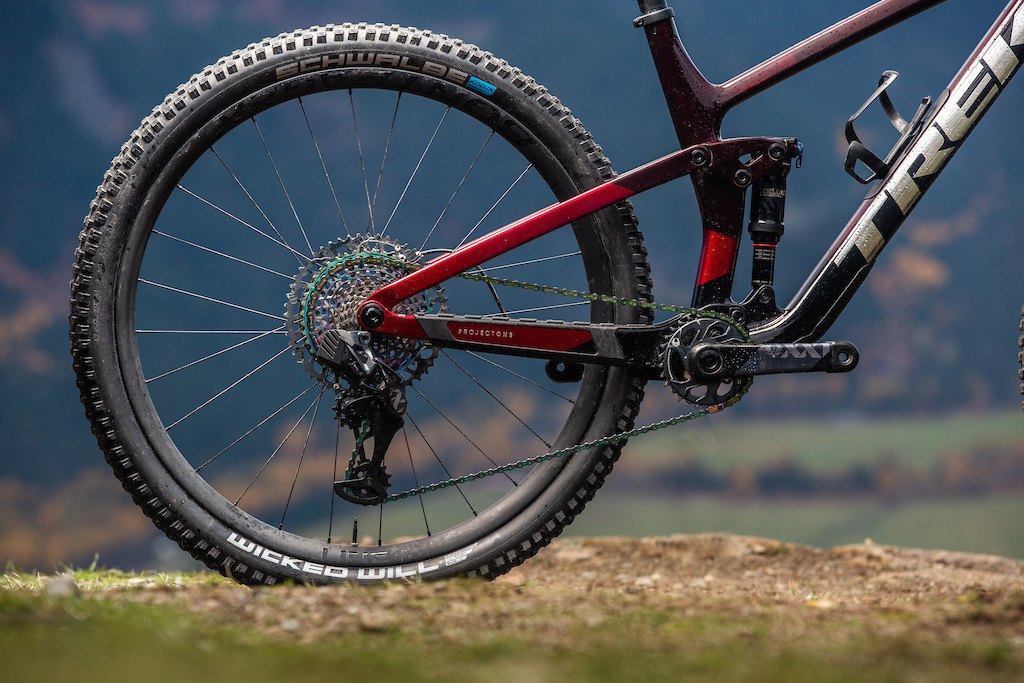
Cool Features
Trek Top Fuel 8 review: a progressive rather than podiuming XC machine
Trek’s top fuel delivers superlative short-travel suspension performance but it’s definitely a trail bike not an xc bike.

BikePerfect Verdict
Awesome suspension, agile swagger, grippy kit and practical frame updates build a brilliant rally bike, but high weight buries any XC aspirations
Infectiously agile and playful vibe
Superlative suspension feel
Seriously tight tracking frame
Trail tough kit
Internal storage
Too heavy for XC racing
Simple fork damper
Tight internal storage access
Yawning gap between this and the Supercaliber
Why trust BikePerfect Our cycling experts have decades of testing experience. We'll always share our unbiased opinions on bikes and gear. Find out more about how we test.
Top Fuel used to be Trek’s out-and-out best full-suspension mountain bike for racing, but with the soft-tail Supercaliber under its sponsored riders now, the Top Fuel has developed a burly rather than race character.
The latest frame, suspension and spec changes to the 8 make the most of its short-travel agility and gripped tenacity to create a proper rally racer. Excess weight shows on climbs and acceleration though.
Design and geometry
The alloy Top Fuel frame not only has the same geometry, shock and suspension layout as its carbon counterpart but Trek’s engineers have also worked super-hard to give it the same extensive, updated feature lineup. That includes the lever-locked trapdoor into the down tube for internal storage, threaded bottom bracket shell with chain guide tabs. The Knock Block 2.0 inset now allows 72-degrees of steering lock (not 58-degrees as before) or you can fit a blank insert for full rotation if the bars aren’t slammed.
In fact, it’s one of those bikes where we continually found ourselves riding how we always want to ride, not how we actually ride. That inevitably builds into an addictive upward spiral of confidence and insolent speed that often ended with us snapping at the heels of more expensive longer travel bikes even on really rowdy trails. Picking a larger, longer frame will settle it even more at speed, but for flow trails, it was refreshing to really rip those big Bontrager side tire lugs round on a compact, close combat chassis. Just be careful you don’t get too carried away, as however good it feels, less travel inevitably means the tires are having to cope with more impact force and we soon put a couple of splits in the rear tire despite the ‘inner strength’ casing.
When that happens the narrow neck of the storage hatch can make getting your spare tube out awkward and the high cage position means you won’t get a large bottle in either. There’s space for a 2.5in tire in the rear swingarm which pivots co-axially around the rear axle according to Trek’s ‘Active Braking Pivot’ wisdom. While it limits choice, the switch to a 34.9mm seatpost size should mean stiffer, smoother dropper action, especially on larger frame sizes which get up to a 200mm shaft stock. The new trunnion style shock pivots more smoothly and is the right way up now compared to last year’s inverted shocks. That means the MinoLink geometry flip chip to change angles by 0.5-degrees is now at the base of the shock but it’s still easy to get too. Significantly all RockShox spec Trek bikes from the 8 upwards get the same ‘Ultimate RCT’ spec Deluxe rear shock.
The alloy frame is a kilo heavier (3.74kg vs 2.7kg) than the carbon option according to Trek’s weights. This saves you $1,400/£1,500 if you buy the frame separately, although it still retails for $2,319.99/£2,350. Those numbers prove it’s neither affordable or light for a bike that you’ll find listed in the XC section of Trek's website, not the trail pages. In fact, the 130mm Fuel EX Al frame is the same weight although that doesn't have internal storage.
A 66/66.4-degree head tube definitely suggests progressive riding rather than traditional podium hunting vibes too. The 465/469mm reach on our M/L size is more trad than rad though so riders after a stretch should make use of the short 450mm seat tube and opt for the L with a 480/484 reach. All bikes get the same 76/76.4-degree seat tube angle and 434/435mm chainstay length though so while having six (S-XXL) sizes is great, the balance is definitely centered around the M - M/L - L models.
Components and build
The Top Fuel 8 is the most expensive alloy bike, above the 7 at $3,529.99/£3,200 and the 5 at $2,629.99/£2,700 (we don’t know what 6 did to offend them but its missing from the line-up), but below the carbon-framed 9.7 at $4,229.99/£4,700.
The highlights of the package are the lightweight SID fork (albeit with the simplest Rush Damper) and Shimano XT rear mech and shifters. The Bontrager XR4 tires are some of our favorite welterweight all-rounders too. The SLX crank is a great piece with a 30T ring for easy climbing, but muscle Mary’s will find a 36T fits the frame too. You get a 150mm Trans-X dropper with a Bontrager Arvada saddle on top and 35mm diameter Bontrager Elite 45mm stem and 780mm wide bar.
Deore four-pot brakes just about do the job adequately via 180/160mm rotors but together with the wide rim tubeless Bontrager Line Comp 30 wheels they’re an obvious area where extra weight creeps in and adds up to nearly 14.5kg without pedals.
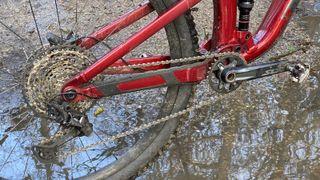
Performance
Add that weight to chunky treaded, relatively grippy tires and however Trek categorizes the Top Fuel, the 8 clearly isn’t the best choice for charging climbs and ripping round simple XC laps. Now we’ve got rid of the people who’ll likely love the 12.2kg Trek Supercaliber for the same money, we can start talking about what the Top Fuel does do really well – and that’s riding properly rowdy.
While bikes like the Evil Following , Santa Cruz Tallboy , and Norco Optic have already established that short-travel bikes can feel awesome, the Top Fuel definitely goes into the small travel, BIG capability hall of fame. Like most of its peers, it doesn’t squander initial shock movement and can feel slightly sharp in the car park unless you drop tire pressures low.
Once moving though it’s both amazingly fluid and connected over ruts and roots whether climbing janky tech or sucking onto stutter bump/root ripple turns or off-camber high lines. The wheel path and rear pivot position mean there’s minimal pull back through the pedals as it hoovers up chunder so you can stay on the gas without getting jacked or stalled out. While we’re always suspicious of acronyms and a 160mm rotor doesn’t generate much torque anyway, the braking performance of the ABP rear end is impressively grippy compared to the same hardware on other bikes.

The RCT damper also has plus and minus low-speed compression settings to fine-tune support sensitivity depending on personal/terrain preferences. Even in the plus setting the mid-stroke mobility does mean you’ll want to flick into the much firmer ‘pedal’ mode if you’re stood up slow cadence churning on a climb or don’t want distracting bounce on long smooth climbs. The SID fork gets a similar firming option via the fork top lever though we rarely touched it unless we were really hanging on a road climb.
While the superlative suspension performance is definitely the heart of the Top Fuel’s ‘have a go hero’ character, the rest of the bike definitely exploits it rather than squandering it. The alloy frame might be heavy but it’s seriously stout when it comes to squaring up to the trail when things get punchy.
While the simpler Rush damper starts to get seasick and inconsistent well before the back end, the 35mm stanchions do a great job of staying on track. Shorter travel means less dive too and together with well-balanced cockpit dimensions and steering angle gives a really predictable and tenacious target lock.
Despite the hefty weight and relatively slow rear hub engagement the fact you can keep the power down or brake really late meant the Top Fuel always felt hyped to be hitting trails and tweaking lines as fast as possible. The shorter M/L size made it a proper joyride on tighter, twistier trails but you can still drive it really hard, heels down, feet level through turns and it loves to pump downslopes.

Trek’s Top Fuel 8 is a brilliant example of just how good short-travel suspension can feel, and less stroke always means a more responsive, visceral ride than a leggier bike. The geometry and proper trail tires really let you exploit the hooligan that’s hiding in the frame along with your pump, tool and spare tube too.
As much as we’ve loved ripping around the trails on it, there’s no doubt it’s heavier and harder to accelerate/elevate than we’d like for its supposed XC/downcountry range placement though. If you’re about the overall vibe, not outright velocity, that doesn’t matter though.
Test conditions
- Temperature: -2 to 8 degrees
- Surface: Mixed blue-black trail center, moorland tracks, off-piste wooded tech and DH
Tech Specs: Trek Top Fuel 8
- Price: $3,829.99 / £3,850
- Model: Trek Top Fuel 8
- Discipline: XC/downcountry/trail
- Head angle: 66/66.4-degrees
- Frame material: Alpha Platinum Aluminium
- Weight: 14.46kg
- Wheel size: 29 x 2.4in
- Suspension: RockShox SID 120mm travel, 44mm offset/RockShox Deluxe Ultimate RCT 120mm travel
- Drivetrain: Shimano XT M8100 mech and shifter. Shimano SLX M7100, 10-51 cassette, chain
- Cranks: Shimano XT 30T chainset
- Brakes: Shimano Deore M6000 brakes with 180/160mm rotors
- Cockpit: Bontrager Line 780mm bar and 45mm stem
- Wheelset: Bontrager Line Comp 30 wheels
- Tires: Bontrager XR4 Team Issue 29 x 2.4in tires
- Seatpost: TranzX 150mm dropper post
- Saddle: Bontrager Arvada, steel rail saddle

Guy has been working on Bike Perfect since we launched in 2019. Hatched in Yorkshire he's been hardened by riding round it in all weathers since he was a kid. He spent a few years working in bike shops and warehouses before starting writing and testing for bike mags in 1996. Since then he’s written several million words about several thousand test bikes and a ridiculous amount of riding gear. To make sure he rarely sleeps and to fund his custom tandem habit, he’s also penned a handful of bike-related books and talks to a GoPro for YouTube, too.
Current rides: Cervelo ZFS-5, Forbidden Druid V2, Specialized Chisel, custom Nicolai enduro tandem, Landescape/Swallow custom gravel tandem
Height: 180cm
Weight: 69kg
Selle SMP Dynamic saddle review – butt ugly, butt comfortable
GoreWear C5 Shakedry 1985 jacket review – the last of the great waterproof jackets?
Red Bull TV launches Race Tapes Season 2 – take a deep dive behind the scenes of the 2023 UCI MTB World Cup season
Most Popular
By Richard Owen 22 March 2024
By Paul Burwell 21 March 2024
By Paul Burwell 20 March 2024
By Guy Kesteven 19 March 2024
By Jon Slade 18 March 2024
By Guy Kesteven 12 March 2024
By Richard Owen 8 March 2024
By Graham Cottingham 6 March 2024
By Guy Kesteven 6 March 2024
- MAGAZINE OFFERS
- BIKE INSURANCE
- Best Products
- Maintenance
- Accessories
- Long-Term Reviews
- BikeRadar Podcast
- First Look Friday
- Bike of the Week
- Tech Features
- Routes and Rides
- Bike Galleries
- BikeRadar Bargains
- Buyer's Guides
- Fitness & Training
- Sizing & Fit
- Mountain Biking UK
- Cycling Plus
Best downcountry mountain bikes of 2024 | Top-rated downcountry MTBs and buyer's guide
The top downcountry mountain bikes, tested and rated by our expert reviewers
Steve Behr / Immediate Media
Stan Portus
Imagine a bike that can tackle all-day epic rides with ease and efficiency, cover ground extremely fast and has just the right mix of componentry to fly down descents, and you're on your way to picturing the best downcountry mountain bikes.
Here, we list the best downcountry mountain bikes in 2024, as tested and rated by our expert reviewers at BikeRadar.
A relative newcomer to the mountain bike scene, downcountry bikes are growing quickly in popularity because they give you everything you need and nothing you don't.
Many of these bikes started life as race-ready cross-country mountain bikes, but they have been given some extra travel and a more progressive geometry, while retaining their XC speed.
Not all downcountry bikes are built the same, though. While some are more like beefed-up cross-country mountain bikes , others are closer to the best trail mountain bikes – pared-back and adrenaline-seeking.
We've put together a buyer's guide at the end of this article to help you choose the best downcountry bike for you and to help explain this new category of bike.
Best downcountry mountain bikes of 2024
Transition spur x01.
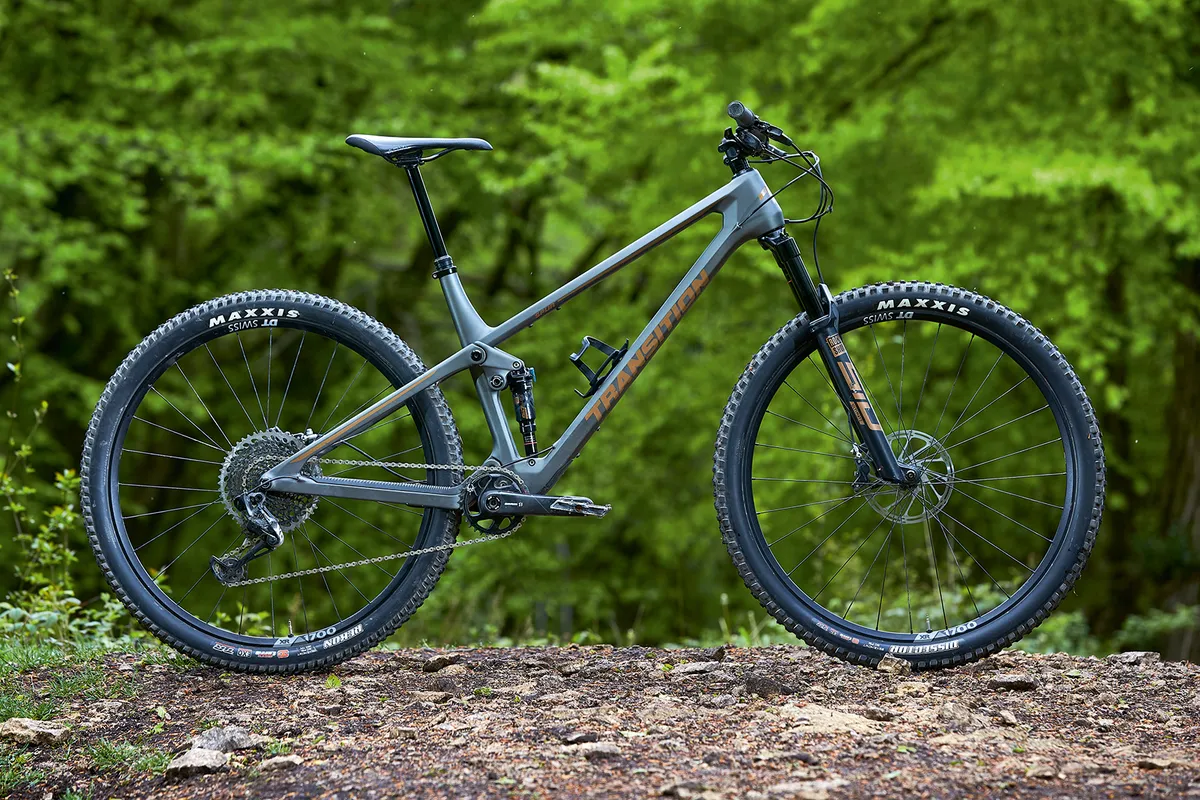
- Great geometry
- Smooth downhill, sprightly uphill
- £6,000 / $6,499 / AU$10,499 as tested
Unlike some downcountry bikes, the full-carbon frame Transition Spur is neither a beefed-up XC machine or a pared-back trail bike. Instead, Transition started from the ground up to build a bike that, it claims, will cover ground quickly and fly down descents.
The Spur has 120mm of travel in both the front fork and the rear shock , and when it comes to descending it really shines a light on how capable a bike like this can be, staying composed with an innate ability to smooth out the trail despite its modest travel.
When climbing, the Spur is quick and efficient, surging forward as you step on the pedals, and staying firmly rooted on rough pitches.
Overall, Transition has created a bike with superb geometry, well-considered kit and a ride that would put many longer-travel bikes to shame.
- Read the full Transition Spur X01 review
Cotic FlareMAX GX AXS
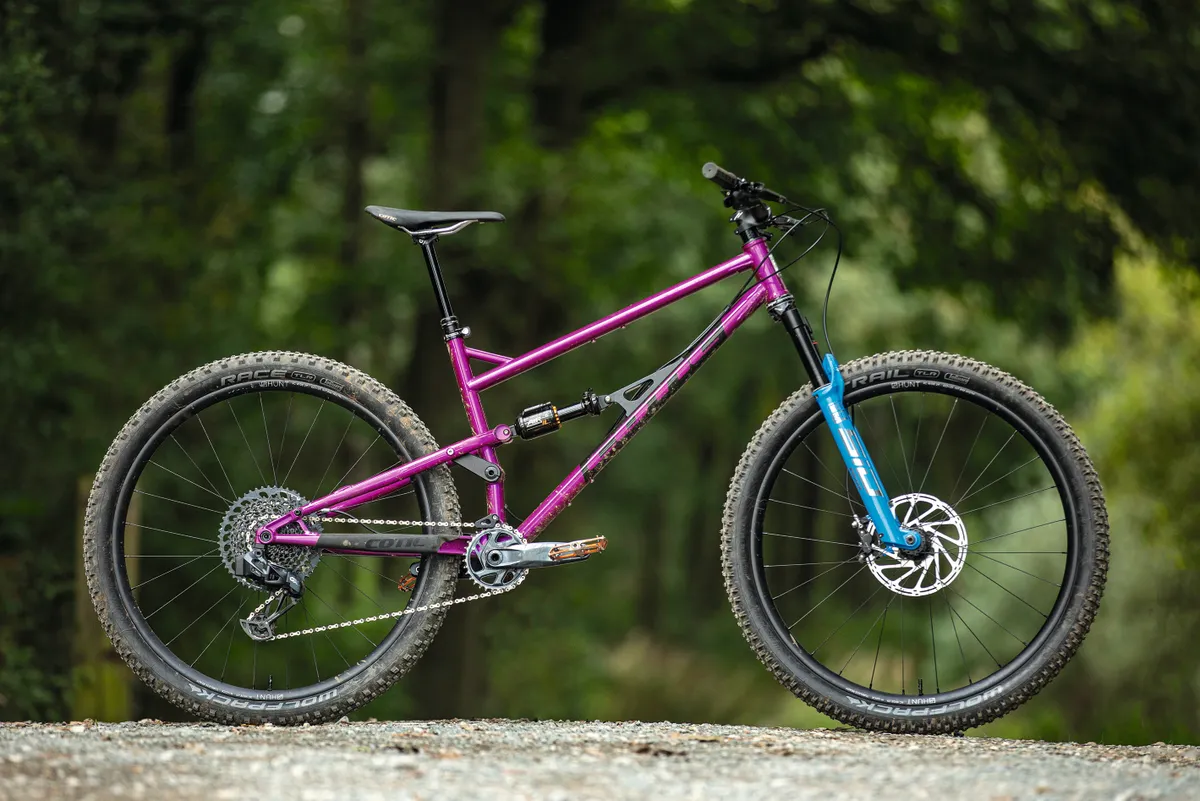
- Very capable downhill
- Fast rolling and responsive
Designed for riding in the UK, the FlareMAX feels capable in most situations, leaning more to the side of ‘down’ in the downcountry equation.
Uphill, the FlareMAX offers tons of traction, accelerating efficiently when you stamp on the pedals. Featuring 125mm of rear travel, the FlareMAX has a ground-hugging feel that never makes it seem under-biked when pointed downhill.
The bike comes well specced with a 120mm RockShox SID fork up front, while Cane Creek's DBair IL takes care of the rear. It also features SRAM’s Eagle AXS drivetrain and G2 RSC brakes, making the bike weigh in at 13.9kg for a size large.
Juliana Wilder CC X01 AXS TR Reserve
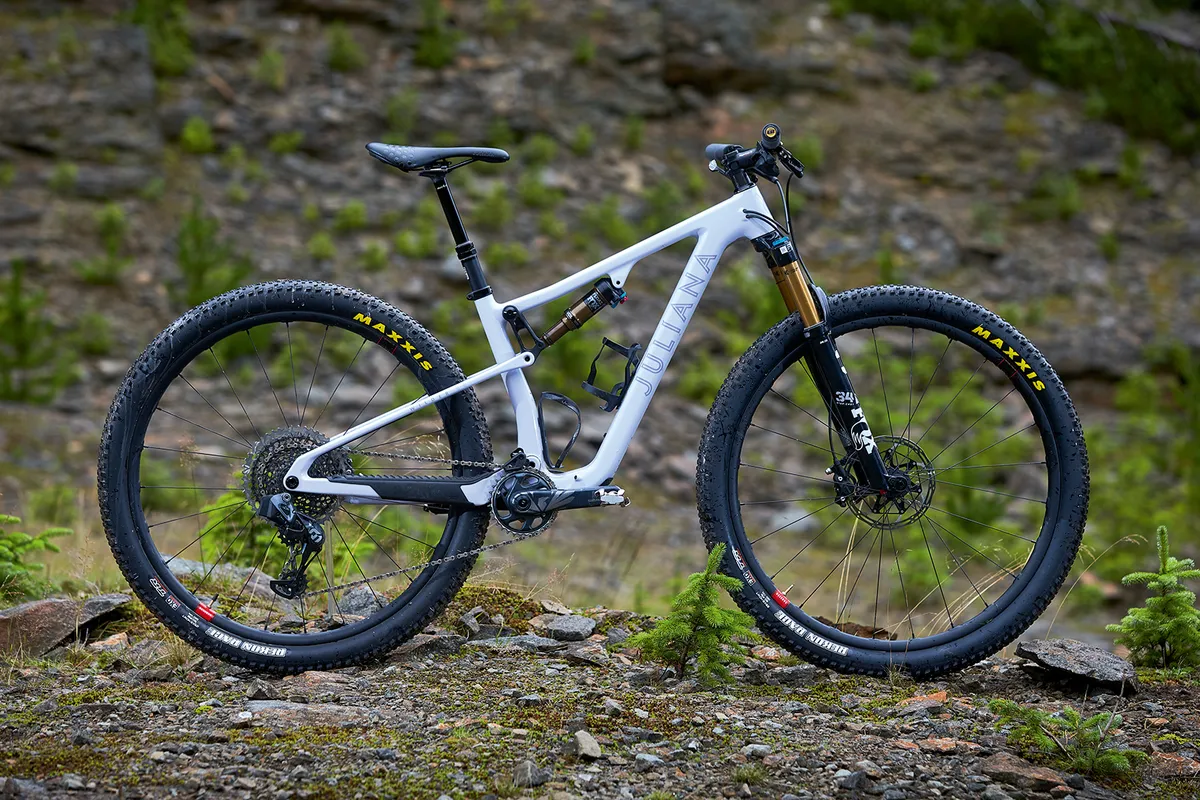
- Super-light, responsive build
- Impressively capable on the descents
- £8,299 / $9,449 as tested
Weighing in at 10.5kg, it’s no surprise that this range-topping new downcountry build from Juliana is a mega climber.
By dropping the VPP linkage, the rear-suspension design has helped to shave 289g off the frame weight of the Blur – the Wilder’s Santa Cruz equivalent – yielding 115mm travel using the single-pivot linkage and flex-stays.
There’s more to this new downcountry rig than pure prowess uphill though: specced with 120mm travel up-front, the Wilder is surprisingly capable when it comes to tackling rougher ground and descents.
- Read the full Juliana Wilder CC Xo1 AXS TR Reserve review
Specialized Epic EVO Expert

- Super-fast when you step on the pedals
- Short-travel but incredibly capable
- £6,750 / $6,300 / AU$10,100 / €6,699 as tested
The Specialized Epic EVO is a rocketship, reflective of its cross-country roots.
On climbs, the bike is sprightly and energetic and gives the feeling that everything you put into the pedals is translated into forward momentum. Slow up a little bit and the bike sits in the middle of its travel and feels more supportive than others.
When you point the Epic EVO downhill, it's surprisingly stable, delivering far beyond its 120mm of travel on rougher terrain, but getting the right line is important to really unlock the bike's potential.
For the price, one might expect a carbon bar rather than the alloy one Specialized has specced, and the brand's in-house tyres could be switched out for some extra bite.
- Read the full Specialized Epic EVO Expert review
Trek Top Fuel 8
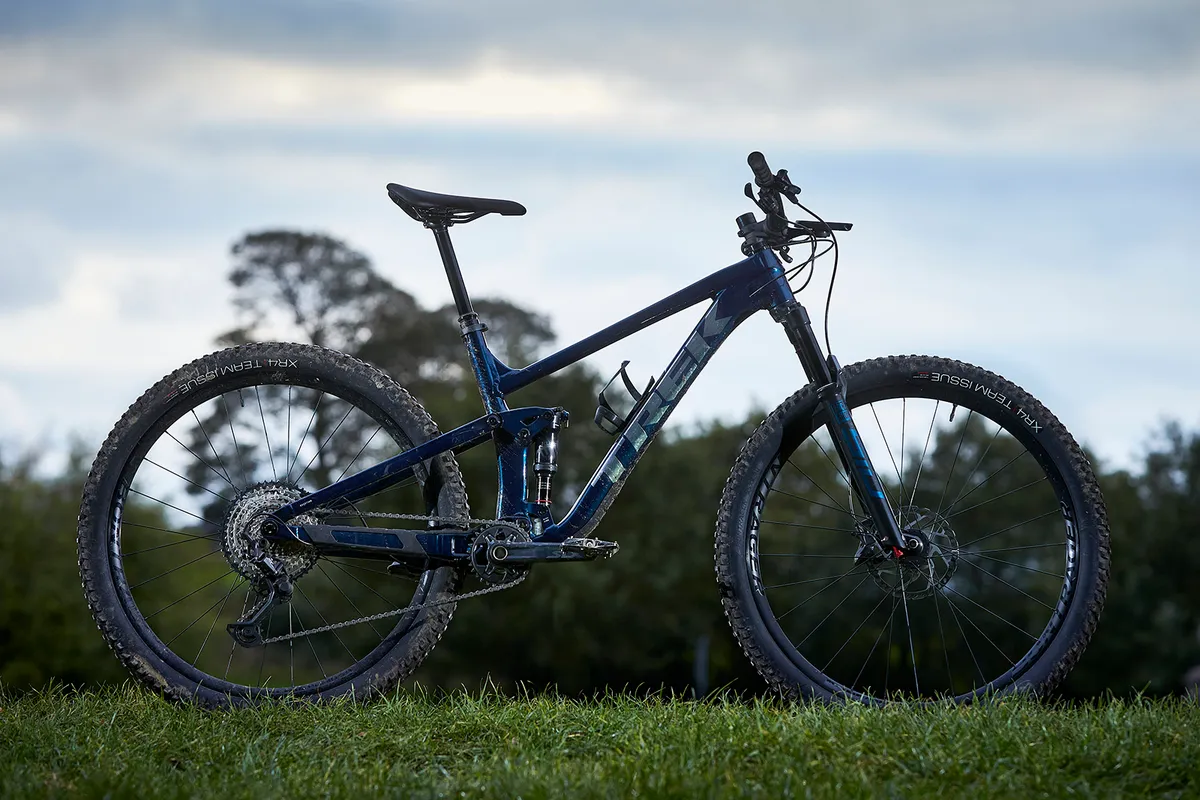
- Ideal suspension and geometry
- Meaty but weighty frame
- £3,850 / $3,830 / €4,099 / AU$5,300 as tested
The Trek Top Fuel 8 won't quite match its rivals on descents, but it's highly versatile, climbing and nullifying rugged surfaces with aplomb.
The modern geometry and gearing of the Shimano XT/SLX groupset allow you to scamper up sheer inclines, provided the Bontrager XR4 tyres retain purchase.
Downhill, the Top Fuel is agile and the RockShox SID fork is only outgunned on the most technical sections.
Unlike an XC bike, the Top Fuel should be forgiving enough to pootle along on all-day adventures.
- Read our full Trek Top Fuel review
YT Izzo Uncaged 7
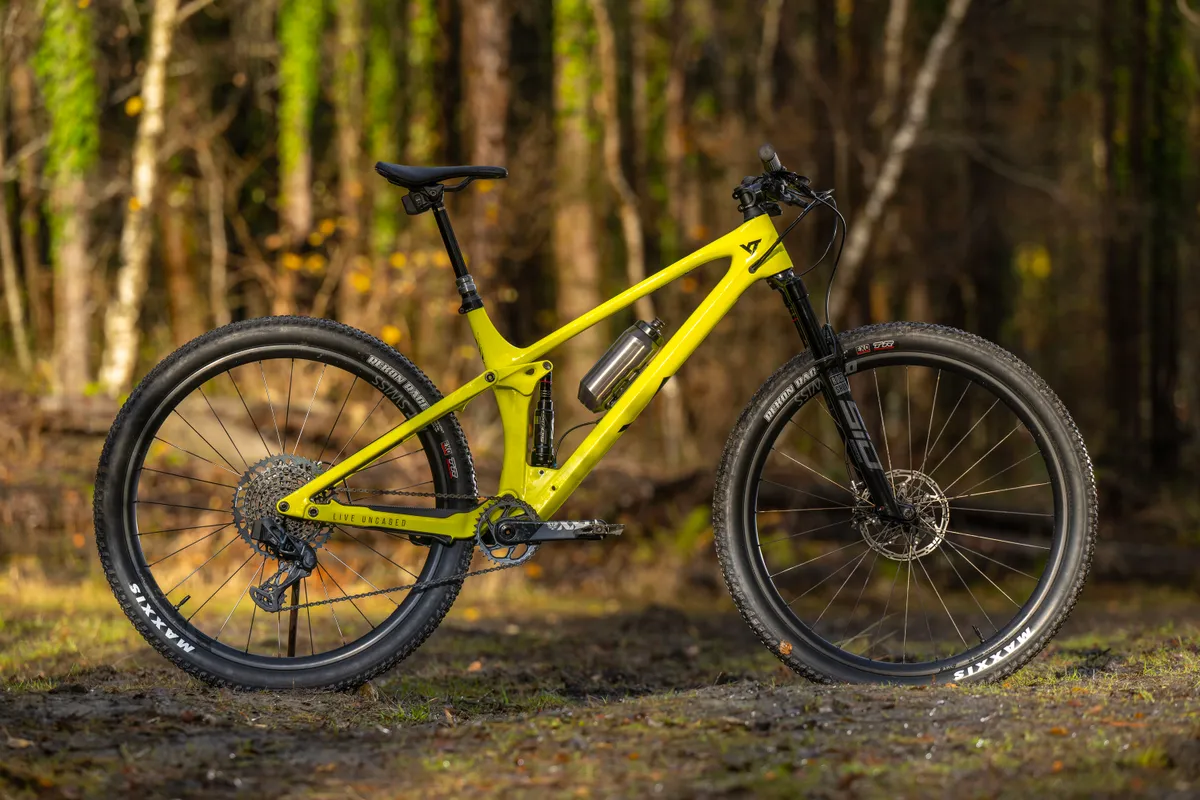
- Modern geometry
- Impressive climbing ability
- Good spec for the money
- £6,299 / $6,499 / €6,299 as tested
The Izzo Uncaged 7 features the same frame as the rest of YTs Izzo range, but features 120mm of travel front and rear instead of the usual 130mm.
Being direct to customer, YT has provided a high spec for the money featuring SRAM's XX1 AXS groupset and G2 Ultimate brakes. A full carbon frame and the carbon DT Swiss XCR 1200 wheels make covering ground quick and easy.
Descending is at the core of the Izzo, though meatier tyres would allow it smash gnarlier trails.
- Read our full YT Izzo Uncaged 7 review
Nukeproof Reactor Carbon 290 ST

- Downhill demon
- Great spec for the price
- £4,700 / $4,700 / AU$6,600 as tested
The Nukeproof Reactor ST is a really capable bike that comes with progressive geometry and a good riding position.
Considering the price point of the Reactor ST, the kit that is bolted to it is really impressive. There is a Fox Factory 34 fork, a Shimano XT 12-speed groupset, Maxxis rubber and carbon handlebar.
On descents, the Fox 34 feels well-controlled and the 125mm of travel in the rear can take some pretty big hits, creating a ride that is seriously fun.
The Reactor ST isn't energetic on climbs and locking the shock is advised to get a bit more efficiency on long drags. This means the Reactor ST isn't quite as rounded as other downcountry bikes, but when it comes to descending and value for money, it's hard to beat.
- Read our full Nukeproof Reactor Carbon 290 ST review
Scott Spark 900 Tuned AXS
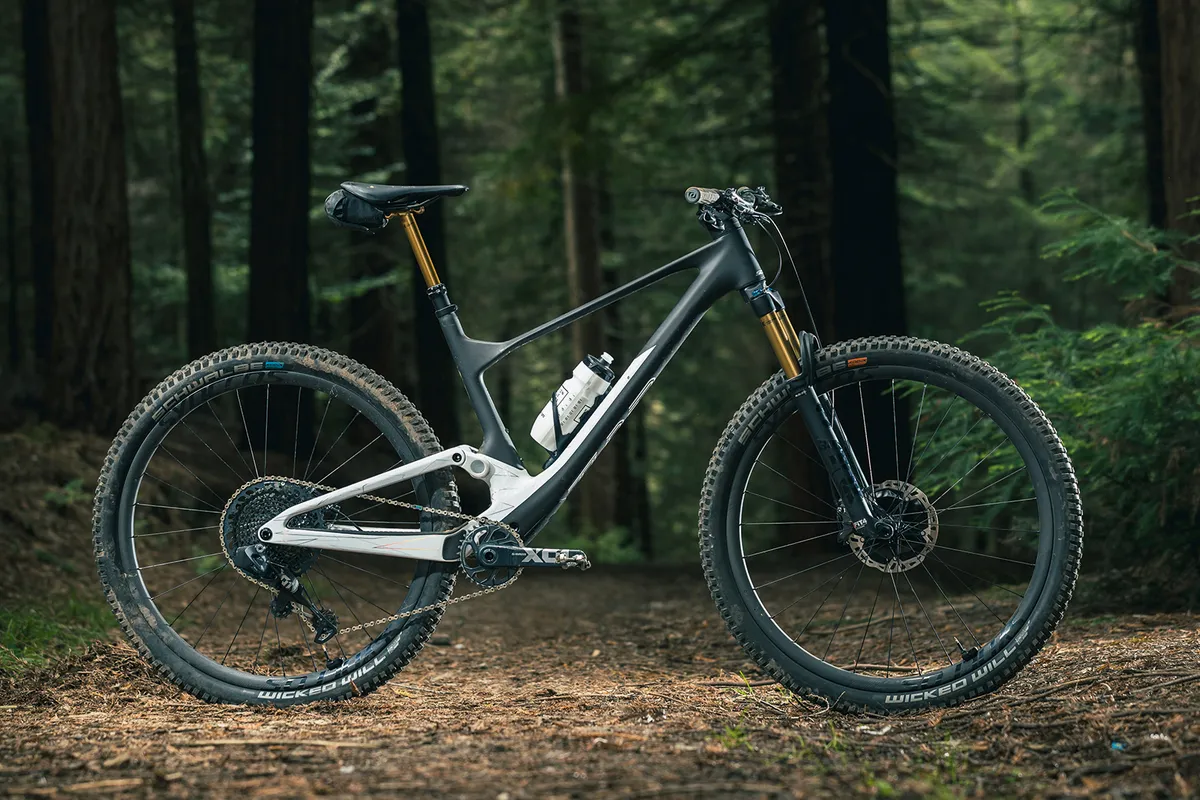
- Lightning fast
- Suspension eases over bumps
- £8,199 as tested (international pricing TBC)
Even in its downcountry guise, with a 130mm-travel fork, the Scott Spark 900 Tuned AXS is suitably rapid. This is in part due to the Fox Nude 5T shock and fast-rolling Schwalbe Wicked Will tyres.
Thankfully, the Shimano XTR brakes can cool off that speed.
Although the Scott Spark whizzes up rock-strewn ascents, on leveller ground the suspension tends to absorb power from the pedals instead of propelling the bike forwards.
- Read the full Scott Spark 900 Tuned AXS review
Scott Spark 910

- Very fast, devours climbs
- Clean hardware
Sharing its frame with the Spark RC cross-country race-bike, the Spark 910 is a fast mile-munching monster with top-of-the-class climbing ability.
The Fox Nude rear shock provides 120mm of travel and is hidden away in the seat tube, creating a clean-looking frame and protecting the shock from the elements. A 130mm Fox 34 fork supports the front end, and the bike is specced with Shimano's XT drivetrain and features a Syncros Fraser integrated bar and stem.
Unlike some downcountry bikes, the Spark is still very much 'country' focused, and is more at home at trail centres rather than gnarly backcountry descents.
Also consider…
This downcountry mountain bike scored fewer than four out of five stars in testing, but is still worth considering.
Cannondale Scalpel SE LTD Lefty
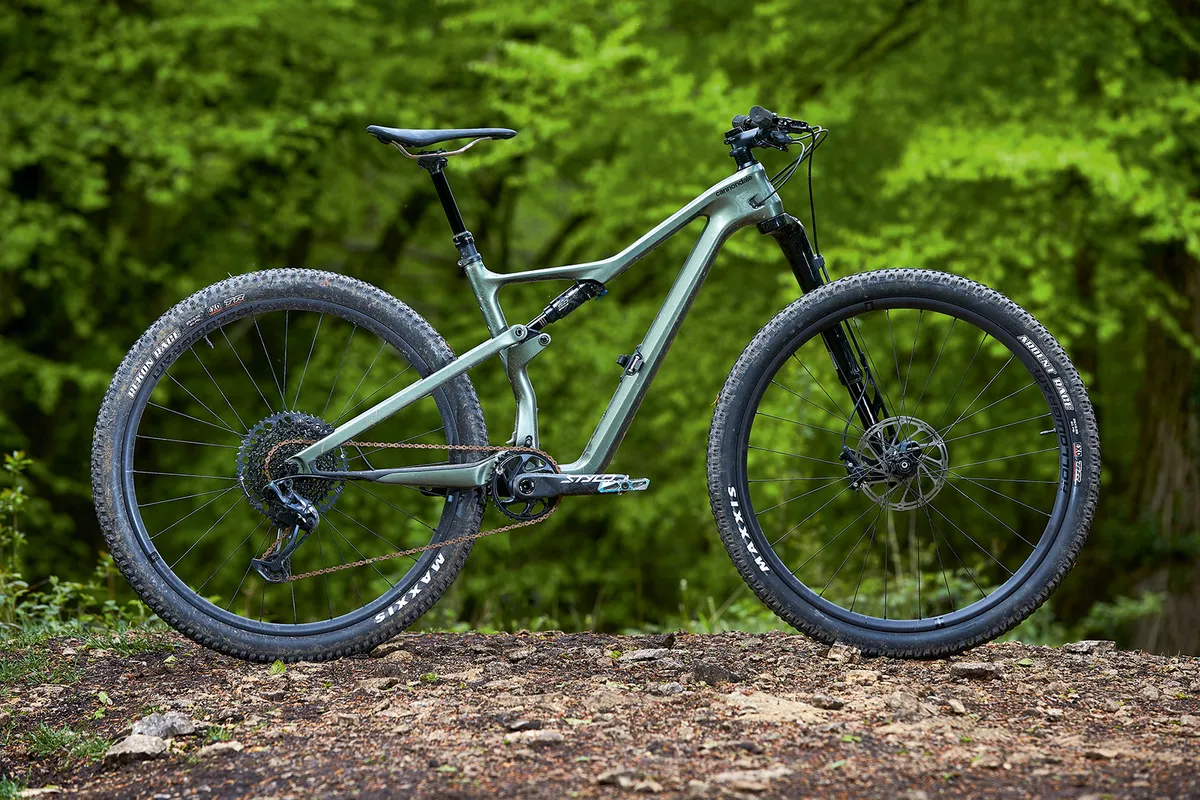
- Incredibly comfortable
- Agile and fun
- £7,000 / $8,300 / €8,399 as tested
The Scalpel SE LTD Lefty shares the same carbon frame as Cannondale's XC Scalpel but has a longer stroke shock to increase the travel from 100mm to 120mm.
This cross-country DNA is apparent in the handling, with the Scalpel eager to get moving and climb. The bike doesn't feel quite as supportive or as bob-free as other downcountry bikes, but on long straight climbs, it can go along at a good pace.
The Scalpel really shines on meandering downhills. It slithers over roots and rocks with ease and is nimble on flowing trail park descents. But rougher terrain will reveal the limits of the Scalpel quicker than other similar bikes.
Having said this, if you're looking for a downcountry bike more at the XC end of the spectrum, the Scalpel is ready to eat up some big miles and comfortably cut through singletrack too.
- Read the full Cannondale Scalpel SE LTD Lefty review
First ride recommendations
These downcountry bikes have only been ridden by the BikeRadar testers a handful of times, so they haven't yet been given a full, rated review, but they are worth considering.
Yeti SB115 T1
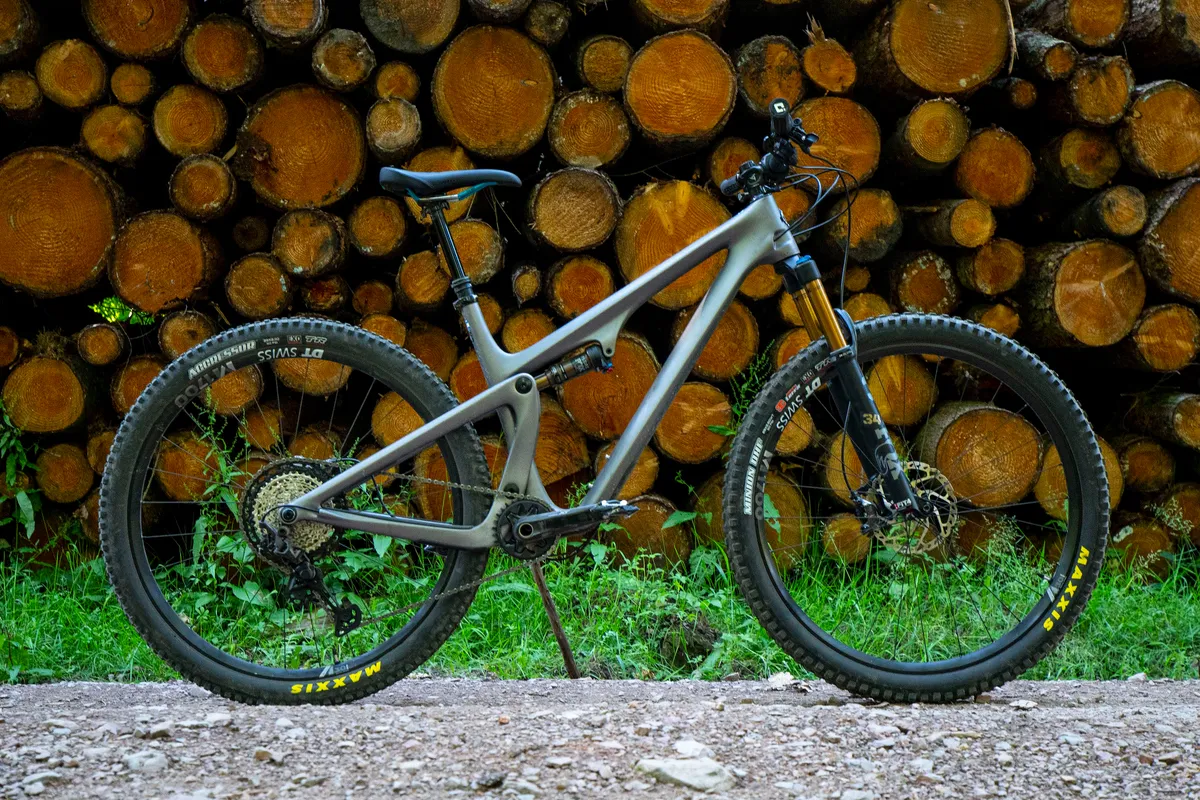
- Supple and supportive suspension
- Super-solid chassis
- £6,499 / $6,300 / €7,490 as tested
Adapted from Yeti's SB100 cross-country bike , the SB115 T1 is a solid bike that feels very planted through the chunder but efficient on the climbs.
The SB115 is graced with Fox Factory suspension that comes up trumps. High anti-squat figures keep the bike feeling stable on climbs.
On descents, it is soft enough to keep the rear wheel stuck to the ground and with enough mid-stroke support for some good pop. It also ramps up nicely for bigger hits, even though there is just 115mm of travel in the rear.
The geometry of the Yeti is fairly similar to the SB100, which contributes to its speed, but the reach is short and it could do with a bit more length to remain stable and less skittish on loose rocks and steep chutes.
- Read the Yeti SB115 T1 first ride review
Buyer’s guide to downcountry mountain bikes
Mountain biking often feels like a broad umbrella for many different disciplines; from trail to high-flying downhill, there are myriad riding styles and, of course, the bikes to match.
Downcountry bikes are one of the latest mountain biking phenomena, sitting at the intersection of cross-country, trail and all-mountain bikes.
Having existed in one form or another for a number of years, downcountry bikes have recently hit the mainstream. As demand for this type of bike began to balloon, the bike industry responded, and downcountry is now a burgeoning category.
Different brands approach downcountry bikes in slightly different ways, but this buyer’s guide will take you through everything you need to know.
What is a downcountry mountain bike?

In short, downcountry bikes are lightweight XC-style frames with added travel, trail-friendly geometry and wider, knobbly tyres.
The result? Bikes that will cover ground extremely fast but still enable you to charge down descents.
The term 'downcountry' was coined by Mike Levy at PinkBike three years ago, and is a mash-up of 'downhill' and 'cross-country'. So, a pretty neat encapsulation of what the bikes are for, and consequently a term that has stuck around.
The origin of downcountry bikes is a bit hazy. Some say it extends back to cross-country racing, where gnarlier courses demanded more technical, gravity-capable machines. Others say it comes from engineers making small tweaks to thoroughbred XC race bikes to make them more fun to ride.
Arguably, they could stem from manufacturers doing their market research and seeing consumers riding more extreme terrain on their cross-country bikes and making corresponding upgrades to existing bikes.
However they came to be, some of the biggest bikes brands now offer off-the-shelf downcountry bikes that deliver a refined balance of short travel, minimal mass and progressive geometry.
What to look for in a downcountry mountain bike
Alongside trail-friendly geometry, wide knobbly tyres and extended travel, downcountry bikes have a few other features that help them balance their fast and agile ride with their downhill performance and more relaxed feel.
Much of what makes a downcountry bike is what it is specced with, and here we run through the key things to look out for.

A lightweight frame with a relaxed geometry
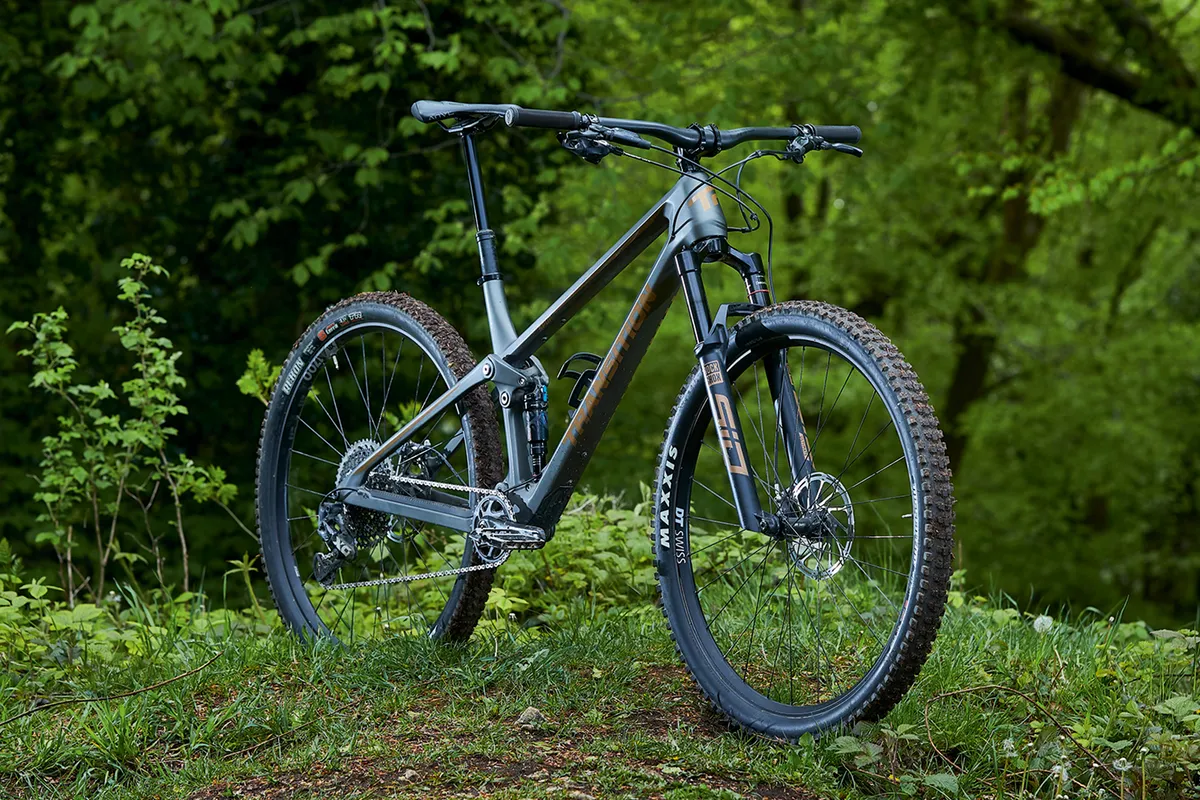
Go back 10 years and tell a cross-country rider they’d one day be riding a bike with a 66-degree head tube angle and they’d probably look at you as if you’d had one too many caffeine gels. But now, this is exactly what is happening with downcountry bikes.
This angle is slacker than traditional cross-country bikes and helps give downcountry bikes their gravity-riding potential. This is because a slacker angle means the front fork sticks our further, creating a more stable ride at high speeds.
Reach figures have also increased as head angles have decreased. A longer reach number makes the bike feel more stable when you’re stood on the pedals descending.
Descending stability was going to be an inevitable outcome when combining the slack head angle, long reach and the consequential longer wheelbases created by those two figures.
Even though downcountry bikes have more gravity-friendly geometry, they remain relatively light so riders aren’t pushing too much mass, helping the bikes stay fast.
Short-travel

Although downcountry bikes have a short-travel design, they still offer a bit more travel than cross-country race machines to help them on more technical downhill sections.
As a general rule, downcountry bikes have between 120mm and 130mm travel in the forks and a variation of between 110mm and 125mm at the back, depending on brand and model.
Some downcountry bikes do offer more travel, but this is testament to how downcountry is a rather woolly category that is more about different factors coming together than travel defining what the bike is.
Large wheels and burly tyres
29in wheels are standard on downcountry bikes. Compared to 27.5in wheels, they require less effort to keep their momentum and are consequently more efficient, making them the right choice for the sorts of longer, more pedalling-intensive rides you’ll be doing on these bikes.
Downcountry bikes pair 29in wheels with wider and burlier tyres than you would expect to find on 29er cross-country bikes.
These mountain bike tyres sit between fast-rolling, lightweight XC tyres and chunkier downhill treads, making them fast and less of a drag when climbing, yet more durable and capable on the rough stuff.
Wide bars and short stems

Wide bars and short stems are the go-to for downcountry bikes.
The wide bars give you more leverage and help make downcountry bikes super-stable, agile and less skittish than bikes with more XC-focused components.
A shorter stem also improves handling. It gives the bike quicker handling characteristics by making steering more direct and makes the bike feel more responsive.
Dropper seatposts
Dropper posts are a common feature on downcountry bikes because they give riders a bit more space for moving around and shifting weight on technical descents.
It’s possible to raise the saddle for efficient pedalling and to make the most of downcountry bikes’ cross-country-style speed, combining the best of both worlds.
It might not be a surprise that downcountry bikes come with dropper posts considering their versatility, and dropper posts are even making their way onto gravel bikes .
Gearing on downcountry bikes is slanted towards the cross-country end of the spectrum. Front rings tend to have between 32 and 38 teeth compared to the 30- to 34-tooth rings on trail bikes.
This allows for more speed, which is always appreciated on the smoother trails and fire roads that a downcountry bike is at home bombing along, and for long days in the saddle.
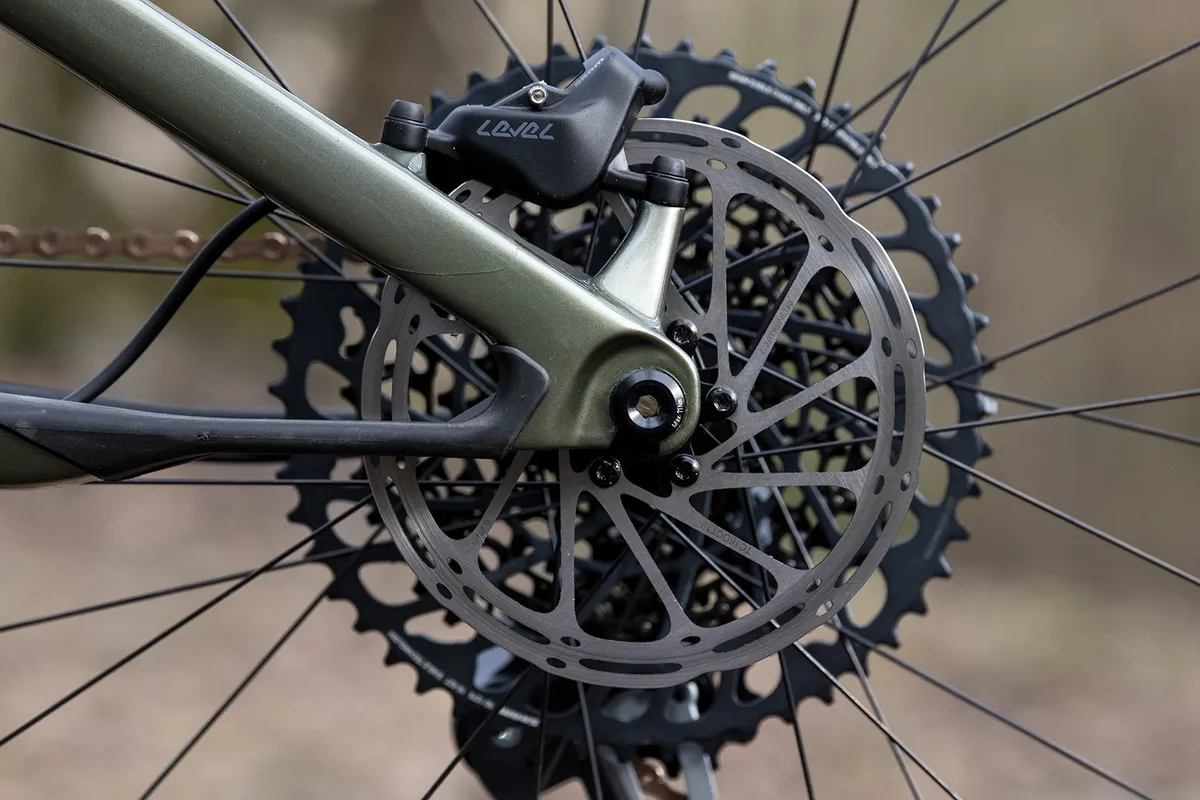
When it comes to brakes on downcountry bikes there is a mix, but they tend to use two-pot rather than four-pot mountain bike disc brakes , where there are only two pistons rather than four.
This is because downcountry bikes don't need the braking power of four pistons because they aren’t descending at the fast, white-knuckle speeds of downhill mountain bikes .
Two pistons rather than four also saves weight, helping downcountry bikes achieve their svelte builds.
In keeping with this, downcountry bikes also tend to have a mix of rotor sizes; 180mm on the front for better braking and heat dispersion and 160mm on the rear, where braking isn’t so strenuous on the disc and a few grams can be saved.
Share this article
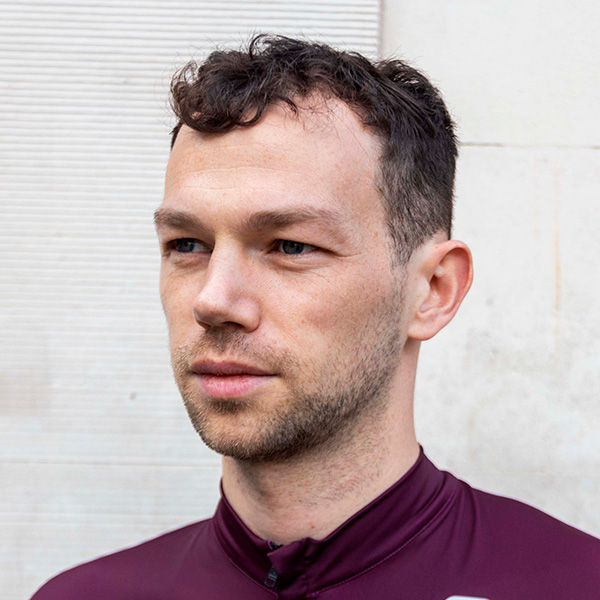
Content editor

- Terms & Conditions
- Subscribe to our magazines
- Manage preferences

- Active Topics
- Create Topic
- Buyer’s Advice
Trek Top Fuel 9.8 or Santa Cruz Blur S build
By marne44 April 6, 2018 in Buyer’s Advice
Recommended Posts
Hi everyone! I'm in the process of replacing my bike and I am completely stuck with a decision between the Trek Top Fuel 9.8 and the Santa Cruz Blur S build.
They are very similarly priced, weigh almost exactly the same (websites) and have very similar components. The Trek has carbon wheels, handlebar and seat-post, but an alu chainstay. The Santa has a complete carbon frame, but alu wheels, handlebar and seat-post.
Any advice, suggestions or feedback regarding the bikes would be much appreciated.
Thanks in advance.
Link to comment
Share on other sites.

Grease_Monkey
I'd go for the Trek because of the fact that it already has carbon wheels, seatpost, and handlebar. On a top end XC bike those are things you most probably are going to upgrade if you it's not already carbon. So in my mind to get the Santa to the same place as the Trek you can add another 15k to the price tag (depending on what wheels you get for the Santa). Personally I like an alu chainstay, when I fall that part of the bike tends to make contact with stones and other objects more than any other part - so it's a plus point in my books.
Trek just delivers better value for my money, and I prefer the way the Trek looks (very subjective - and when spending that amount of money I want a bike I think is pretty!)
DieselnDust

WeekendWarrior80
I might be slightly biased, but the SC all the way. Also room for some weight loss over time...

Greg rides a santa cruz, Emily rides a trek. Greg is faster. If you want to catch Emily you'd better be faster than her... SC all the way. I'd go for the intense

Drive to Paarl, speak to Danie at Cycle4Life. They are TREK dealers. Take it for a test ride ....
Test the others, then take the TREK for a second test ride.
I LOVE my Trek !!!!! YES, the others in this price class certainly is not "bad" .... I just love the handling of the TREK. Did a ride today in a NEW area, going blind into corners, dealing with everything a trail can throw my way - with not knowing what is waiting around the next bend. Obviously had to grab the brakes a few times. Not once did I even feel remotely "on the edge". The Trek geometry is very forgiving, and suits me.
You would need to ride it to see which bike suits YOUR riding style and experience level ...
SC - masters of dual sus design, arguably a cooler brand. Lifetime pivot bearing replacement, too.

Brett MTBer
So they same weight and the Trek has carbon rims? that means its basically heavier - apples with apples - SC all the way, at least its going to be a cool bike and you can loose weight as you can afford to - I have one so not bias at all..
- 2 weeks later...
Hi Brett! Thanks for your response. Do you have a Blur?
Drive to Paarl, speak to Danie at Cycle4Life. They are TREK dealers. Take it for a test ride .... Test the others, then take the TREK for a second test ride. I LOVE my Trek !!!!! YES, the others in this price class certainly is not "bad" .... I just love the handling of the TREK. Did a ride today in a NEW area, going blind into corners, dealing with everything a trail can throw my way - with not knowing what is waiting around the next bend. Obviously had to grab the brakes a few times. Not once did I even feel remotely "on the edge". The Trek geometry is very forgiving, and suits me. You would need to ride it to see which bike suits YOUR riding style and experience level ...
Hi Chris! Thanks for your response. Can I assume you have a top fuel 9.8?
- 3 months later...
Hi everyone!
After a few messages I received relating this topic I thought I will give an update on why I got the bike I chose. I received the opportunity to take both the Top Fuel 9.8 and Blur S Build for a test ride on the same day on the exact same route. The route was about 10km and consisted of a 2km climb with 190m ascent and a fast and flowing singletrack descent.
I first took the Blur for the test ride. The bike climbed well and descended even better. The biggest impression it made was down the singletrack.
Next was the Top Fuel. I thought the bike climbed better than the blur (the blur was great). The descent was slightly less controlled, but more fun.
Decision: After riding both bikes I realised both are really excellent. Coming from an aggressive hardtail onto these bikes, the Top Fuel felt more at home while climbing. The Blur was good uphill, but the Top Fuel just felt faster. On the descents, the Blur felt so controlled/comfortable that I thought it was too easy. The Blur was quicker down, but the Top Fuel just felt more exciting and on the edge. The Top Fuel is a very nippy bike that made me enjoy the descent more than on the Blur. Based on this experience I went for the Top Fuel.
At the end of the day it all comes down to personal preference. I have ridden my Top Fuel now for two months and haven't looked back.
- ChrisF , MDJ , Jeanb and 2 others

- DieselnDust , peetwindhoek and ChrisF

Hi everyone! I'm in the process of replacing my bike and I am completely stuck with a decision between the Trek Top Fuel 9.8 and the Santa Cruz Blur S build. They are very similarly priced, weigh almost exactly the same (websites) and have very similar components. The Trek has carbon wheels, handlebar and seat-post, but an alu chainstay. The Santa has a complete carbon frame, but alu wheels, handlebar and seat-post. Any advice, suggestions or feedback regarding the bikes would be much appreciated. Thanks in advance.
IS the Trek Top Fuel a recently landed 2018 or 2019 model or an earlier 2018?
I ask because if you're a medium fit on the SC the trek 17.5" size is going to be very tight and the 19.5 may be too big. They started bringing in the 18.5" from June.
I'd get the TREK BTW. I prefer the way the rear suspension remains active through all kinds of terrain without as severe pedal feedback over sharp edged trail obstacles
IS the Trek Top Fuel a recently landed 2018 or 2019 model or an earlier 2018? I ask because if you're a medium fit on the SC the trek 17.5" size is going to be very tight and the 19.5 may be too big. They started bringing in the 18.5" from June. I'd get the TREK BTW. I prefer the way the rear suspension remains active through all kinds of terrain without as severe pedal feedback over sharp edged trail obstacles
At the time I bought the bike the 18.5" wasn't available yet. So went with 17.5". Had to get a longer stem + offset seat-post.
As long as it works for you then thumbs up. I quite like it set up like that but a 100mm stem was just a touch too long. The 18.5" would have swayed my purchase decision
Create an account or sign in to comment
You need to be a member in order to leave a comment
Create an account
Sign up for a new account. It's easy!
Already have an account? Sign in here.
Recent news

Active Discussions
5 hours ago

6 hours ago

All Categories
Electric Bikes
Wheels & Tyres
Accessories
Clothing & Apparel
Events & Services
- Browse Sections
All Event Categories
2022 Trek Top Fuel Review | All-new frame & geometry, with a whole new attitude
The not-so-minor details, 2022 trek top fuel 9.8 xt.
https://www.trekbikes.com/
- Brilliant trail-ripping geometry - Active and supportive suspension - Masses of cornering grip & stability - Refined and practical frame design - Downtube storage is a welcome addition
- Dropper post is sluggish - Wheels are solid but quite heavy - Carbon bars are harsh - Heavier than many of its competitors
Flow reviews the 2022 Trek Top Fuel
The Trek Top Fuel has long been known as the American brand’s flagship full suspension XC race bike, purpose-built to to compete at the very highest level of the sport. In more recent years however, the Top Fuel has steered in a different direction. With the short-travel Supercaliber taking over duties for World Cup XCO racing, Trek has softened the Top Fuel’s serious, race-focused persona, adding travel and bulking it up in the process.
For 2022, the Trek Top Fuel makes its biggest move away from its XC racing roots. Equipped with a brand new frame, an updated suspension design and some thoroughly modern geometry, the Top Fuel aims to retain the pert pedalling performance of its predecessor while significantly boosting its all-round capability. So, has Trek succeeded?
Watch our video review of the new Trek Top Fuel here:

Along with the active ABP suspension design and chunky tyres, there’s an exceptional amount of grip and support on offer for a 120mm travel bike.

Trek Top Fuel overview
Despite being all-new, the Trek Top Fuel retains its position in between the Supercaliber (the 60mm travel XC race bike) and the Fuel EX (the 130mm travel trail bike).
It’s equipped with a 120mm travel fork just like its predecessor, but rear travel has actually lifted by 5mm up to 120mm. This increase has been achieved with a longer stroke shock (50mm vs 45mm), and Trek has also flipped the orientation of the trunnion-mount. The rocker link now drives the shock via two sealed cartridge bearings to improve sensitivity.
You’ll no longer find a dual remote lockout on the Top Fuel, which leads to a vastly cleaner bike with fewer cables occupying your view from the cockpit. Along with the bigger shock, slacker geometry and 2.4in wide tyres, it is without doubt the most trail-oriented Top Fuel we’ve seen yet.
To put it into context, that sees it move away from the likes of the Orbea Oiz TR and the Canyon Lux Trail , and more towards the direction of the Santa Cruz Tallboy and Pivot Trail 429 .
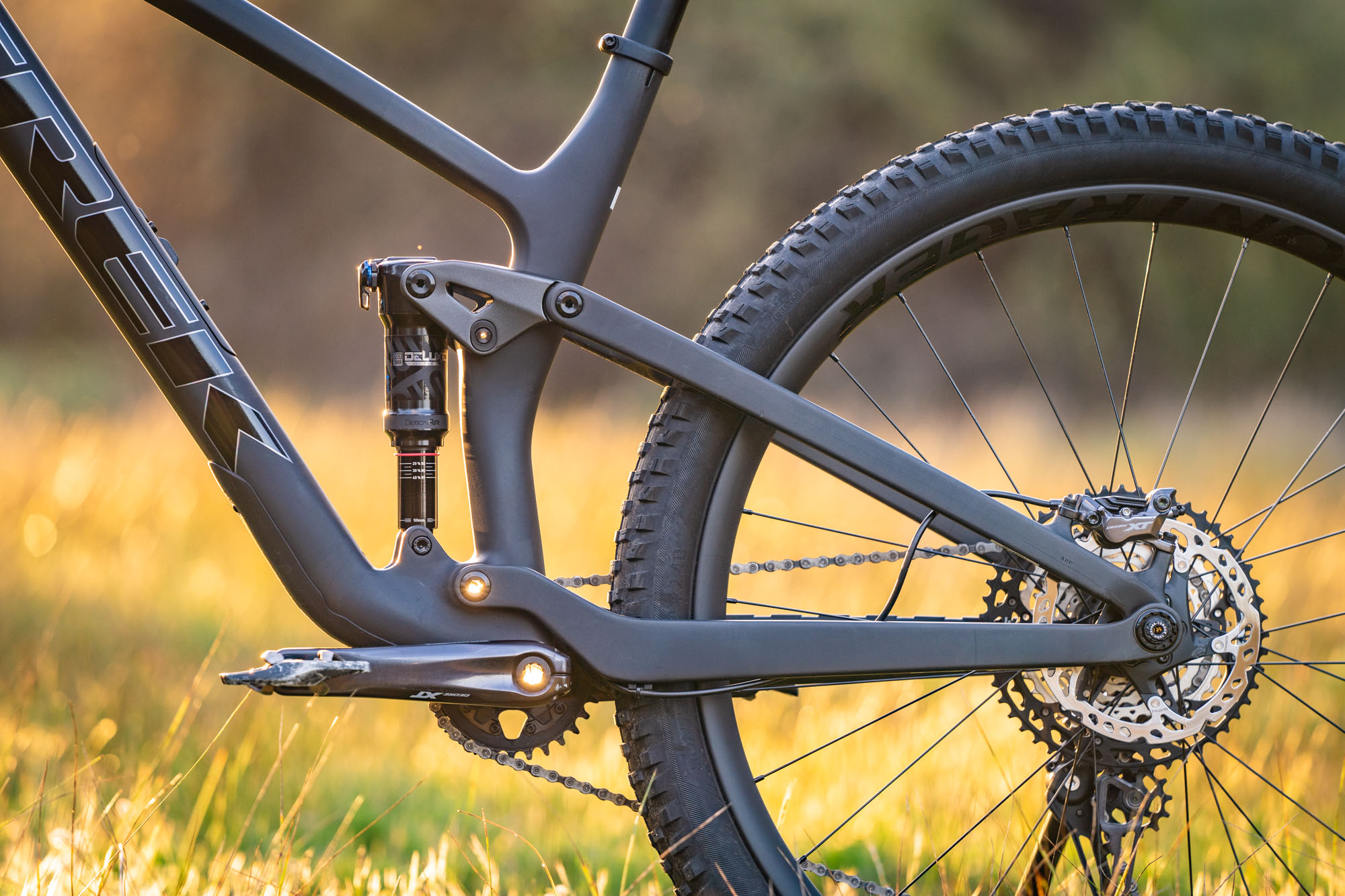
A new, burlier chassis
Though it looks pretty similar, the Trek Top Fuel frame is all-new for 2022. It’s not so much a radical overhaul, but rather a collection of many small refinements that add up to a more practical package.
The chassis is notably beefier than its predecessor, with the seat tube diameter swelling to the new-school 34.9mm size. As well as increasing frame stiffness, the fatter seat tube is also shorter, allowing it to swallow a modern long-stroke dropper post.
The downtube is also larger, and it now features the integrated storage design we’ve seen employed on the latest Fuel EX and Slash. A latch underneath the bottle cage removes the trap door, providing you access within. A neat tool roll is included with the bike so you can carry a spare tube, levers and CO2. You could also fit a lightweight jacket in there along with some snacks.

Trek has updated the Knock Block headset, increasing the available turning radius from 58° to 72°. This provides you with greater freedom of movement on the trail, but still prevents the handlebar controls from smashing into the top tube. If you’re not into it though, the Knock Block is removable.
Also nice to see is a threaded bottom bracket shell for ease of maintenance, and the rear ABP pivot can now be tightened with a cassette tool. Also new for the Top Fuel is guided internal cable routing – poke the cable in at one end, and it’ll pop out the other, no fishing required.
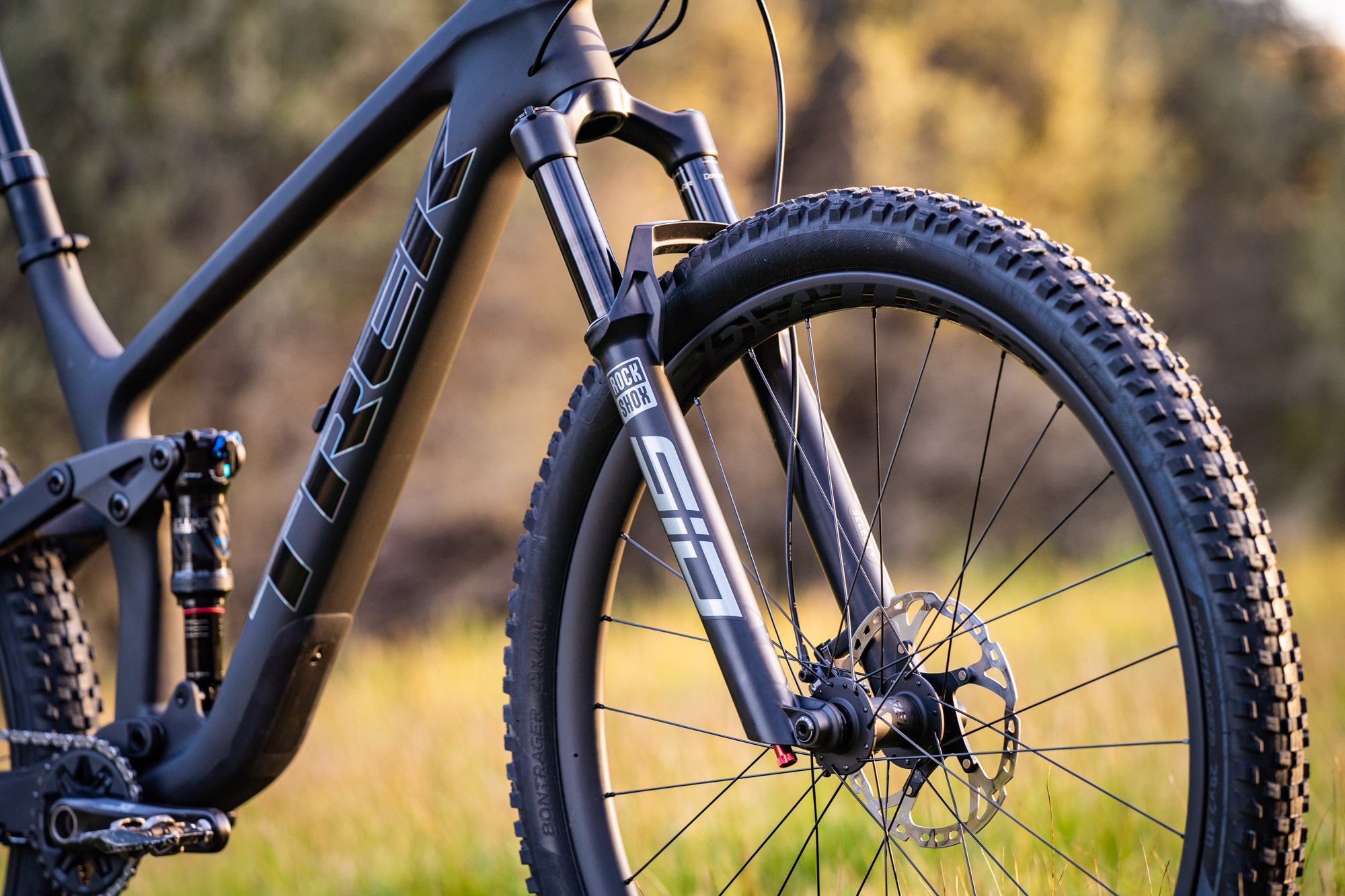
Trail-leaning geometry
The 2022 Trek Top Fuel has received a series of geometry updates over the outgoing model, bringing it up to speed with other boundary-pushers in this travel bracket. Here are the key numbers;
- Head tube angle: 66°
- Seat tube angle: 76°
- Reach: 420mm (S), 450mm (M), 465mm (M/L), 480mm (L), 500mm (XL)
- Rear centre length: 435mm
- BB drop: 36mm
Compared to the old Top Fuel, the head angle has kicked back by 1.5-degrees and the reach measurements have gone up by 10mm. The seat tube angle has also steepened by 1-degree to improve the climbing position, while the chainstay length and BB drop remain the same.
The Top Fuel still features a Mino Link, but it’s now located at the lower shock eyelet. Bikes will come setup from the factory in the Low position. Flipping that into High will lift the BB height by 7mm and steepen the angles by 0.4°.
You can get even rowdier by fitting a 130mm travel fork, which will kick the head angle back to a very-slack 65.6° in the Low position. And for those wanting to push the needle further, there’s clearance to run 2.5in tyres.

Trek Top Fuel price & specs
We’ll see four Trek Top Fuel models coming into Australia this year – two with alloy frames and two with carbon. All Top Fuel models feature the same geometry, suspension design and travel. They’re all equipped with 29in wheels, and there are five frame sizes available from Small through to X-Large (the XS size with 27.5in wheels won’t be available in Australia).
Pricing kicks off at $3,499 AUD for the Top Fuel 5 and goes up to $8,299 AUD for the Top Fuel 9.8 XT that we have on test here. Additionally, Trek will offer a 9.9 spec via the Project One bike builder program.
You can check out the specs and prices for all those models down at the bottom of the page. Right now we’ll be diving straight into our experience of testing this bike here; the Top Fuel 9.8 XT.

- Frame | OCLV Mountain Carbon Fibre, ABP Suspension Design, 120mm Travel
- Fork | RockShox SID Select+, Charger 2 RL Damper, 44mm Offset, 120mm Travel
- Shock | RockShox Deluxe Ultimate RCT, 185x50mm
- Wheels | Bontrager Line Elite 30, OCLV Carbon Rims, 29mm Inner Width
- Tyres | Bontrager XR4 Team Issue 2.4in Front & Rear
- Drivetrain | Shimano XT 1×12 w/XT 30T Crankset & 10-51T Cassette
- Brakes | Shimano XT 4-Piston w/Ice Tech Rotors
- Bar | Bontrager Line Pro, OCLV Carbon, 27.5mm Rise, Width: 750mm (S), 780mm (M-XL)
- Stem | Bontrager Line Pro, 45mm Length
- Seatpost | Bontrager Line Elite Dropper, 34.9mm Diameter, Travel: 100mm (S), 150mm (M-M/L), 170mm (L), 200mm (XL)
- Saddle | Bontrager Arvada, Austentite Rails
- Confirmed Weight | 12.88kg (Large, Tubeless)
- RRP | $8,299 AUD

This differs from some other brands that utilise a single frame, and simply up-fork and up-shock it to create a slightly longer travel bike (like the Specialized Epic EVO and Orbea Oiz TR). The Top Fuel is not one of those bikes.
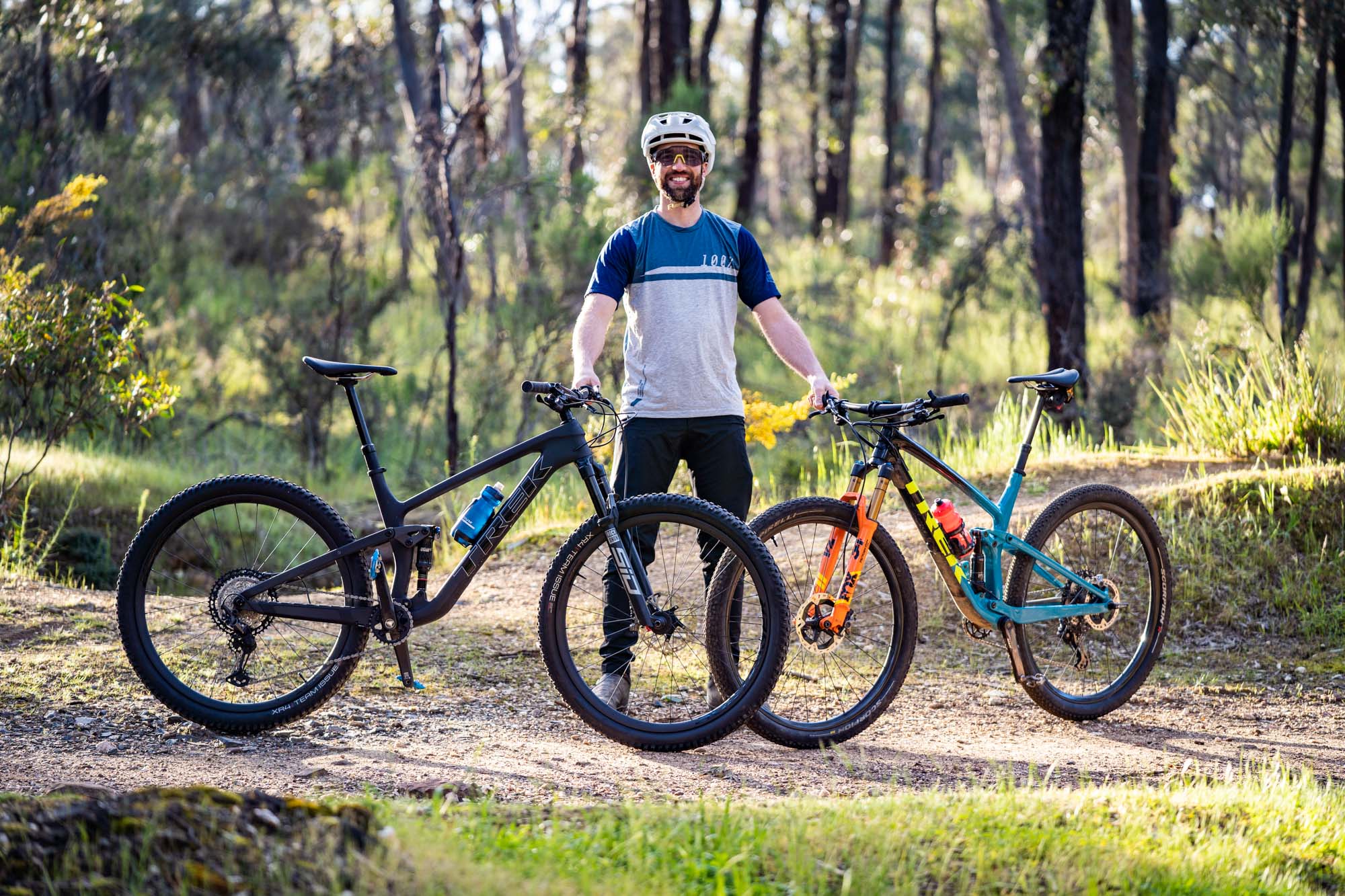
Trek Top Fuel sizing & fit
We put the new Trek Top Fuel into the hands of our tester Ben, who owns the current Top Fuel and has also spent considerable time on the Fuel EX. At 181cm tall, Ben’s been riding a size Large across all three bikes.
The Top Fuel is well-proportioned out of the box. The 480mm reach is very long, but it’s balanced nicely with a 50mm stem and the 76° seat tube angle. The Bontrager saddle is totally inoffensive, and we haven’t needed to shunt it into an extreme position just to get it comfortable.
The 760mm wide riser bars are a great match for this bike, and while it may not be totally necessary for all riders, the 170mm stroke dropper post is fashionably long for such a short travel bike.
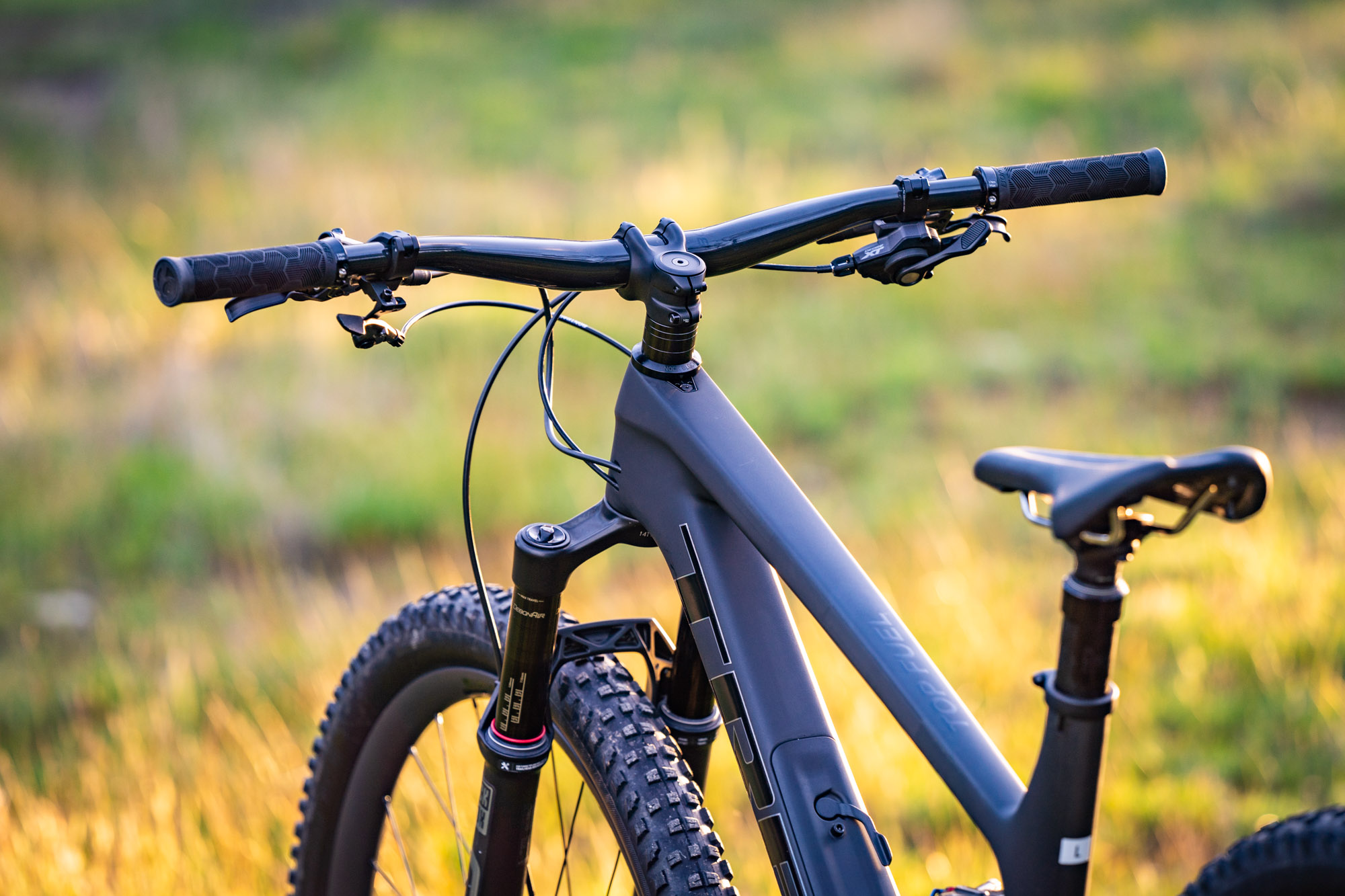
Suspension & tyre setup
With the anodised sag gradients on the fork and shock, suspension setup is made easy. Weighing 80kg loaded up, Ben’s been running 180psi in the rear shock (26% sag) 80psi in the fork (20% sag).
The factory rebound tune for both the RockShox SID fork and Deluxe shock is quite light, so each rebound dial was set a couple of clicks slower than halfway.
Tubeless rim strips and valves come pre-fitted to the Bontrager wheels, and Trek kindly includes two bottles of sealant with the bike, making tubeless setup the breeze it should be. Pressures were set at 20psi on the front and 22psi on the rear.

Trek Top Fuel weight
Given its swollen proportions, the new Trek Top Fuel has gotten heavier. With the tyres setup tubeless, our test bike came in at 12.88kg without pedals. To put that number into perspective, here’s how it compares to some similarly-priced XC and Trail bikes we’ve recently tested;
- Canyon Lux Trail CF 9 – 11.22kg
- Merida Ninety-Six 8000 – 11.63kg
- Scott Spark 910 – 12.43kg
- Specialized Stumpjumper Pro – 12.84kg
- Trek Top Fuel 9.8 XT – 12.88kg
- Giant Trance Advamced Pro 29 1 – 13.38kg
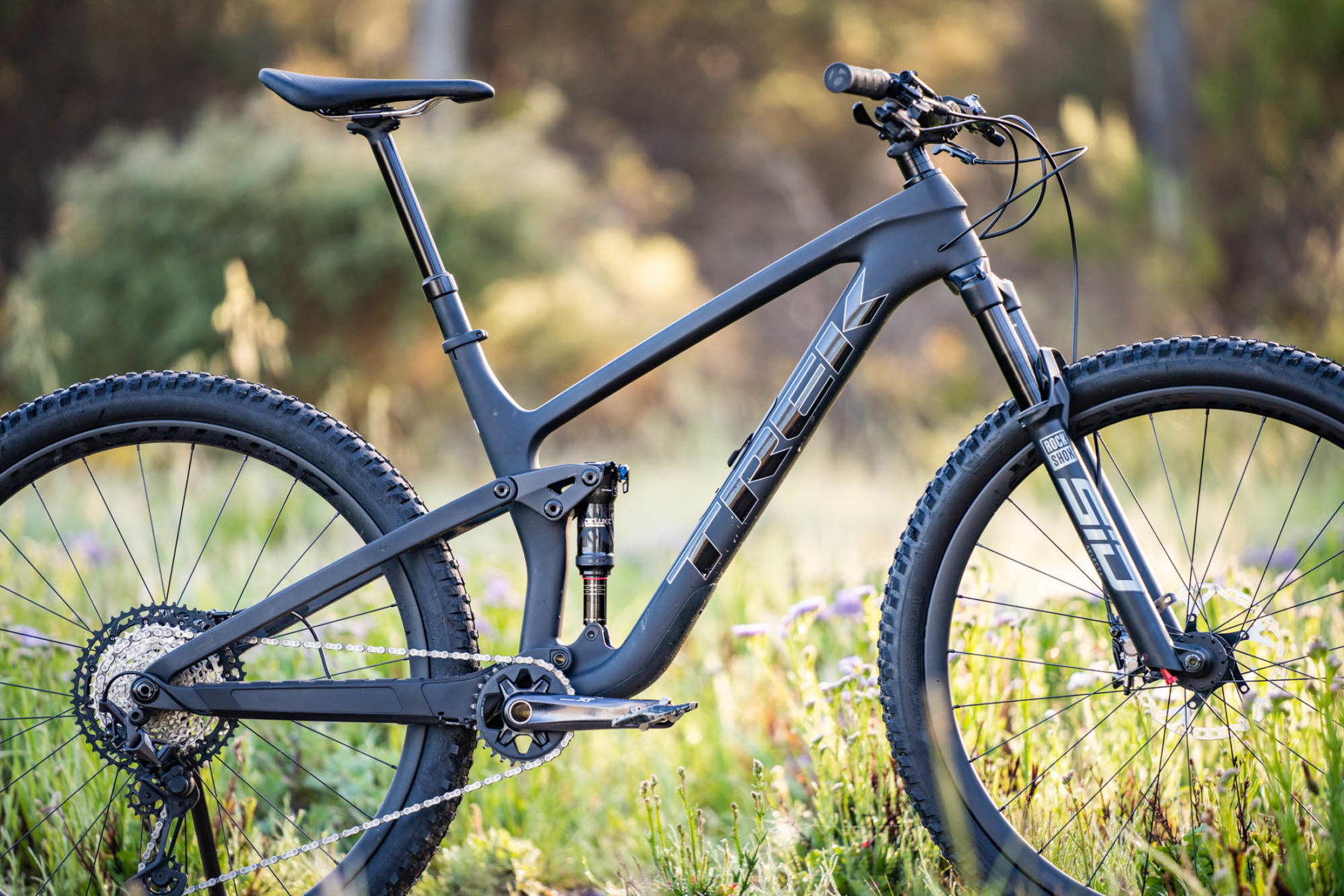
Trek claims a carbon Top Fuel frame weighs 2.7kg including the rear shock, which puts it on the heavier side of things for a 120mm travel bike. The alloy frame is purportedly a whole kilo heavier again, with a claimed weight of 3.74kg.
The Top Fuel’s rolling stock is also a significant contributor to its overall mass. The Bontrager Line Elite wheels are heavy at 2,071g for the pair (with tubeless strips and valves). Incidentally, these are exactly the same wheels that came on the Slash 9.9 X01 , which is a full-bore enduro race bike.
Trek has also plumped up the rubber. The previous Top Fuel featured semi-slick XR3 tyres, but the new bike is now spec’d with 2.4in wide XR4 Team Issue tyres. They’re not overly heavy at around 800g each, though they do offer significantly better grip across a broader range of conditions.
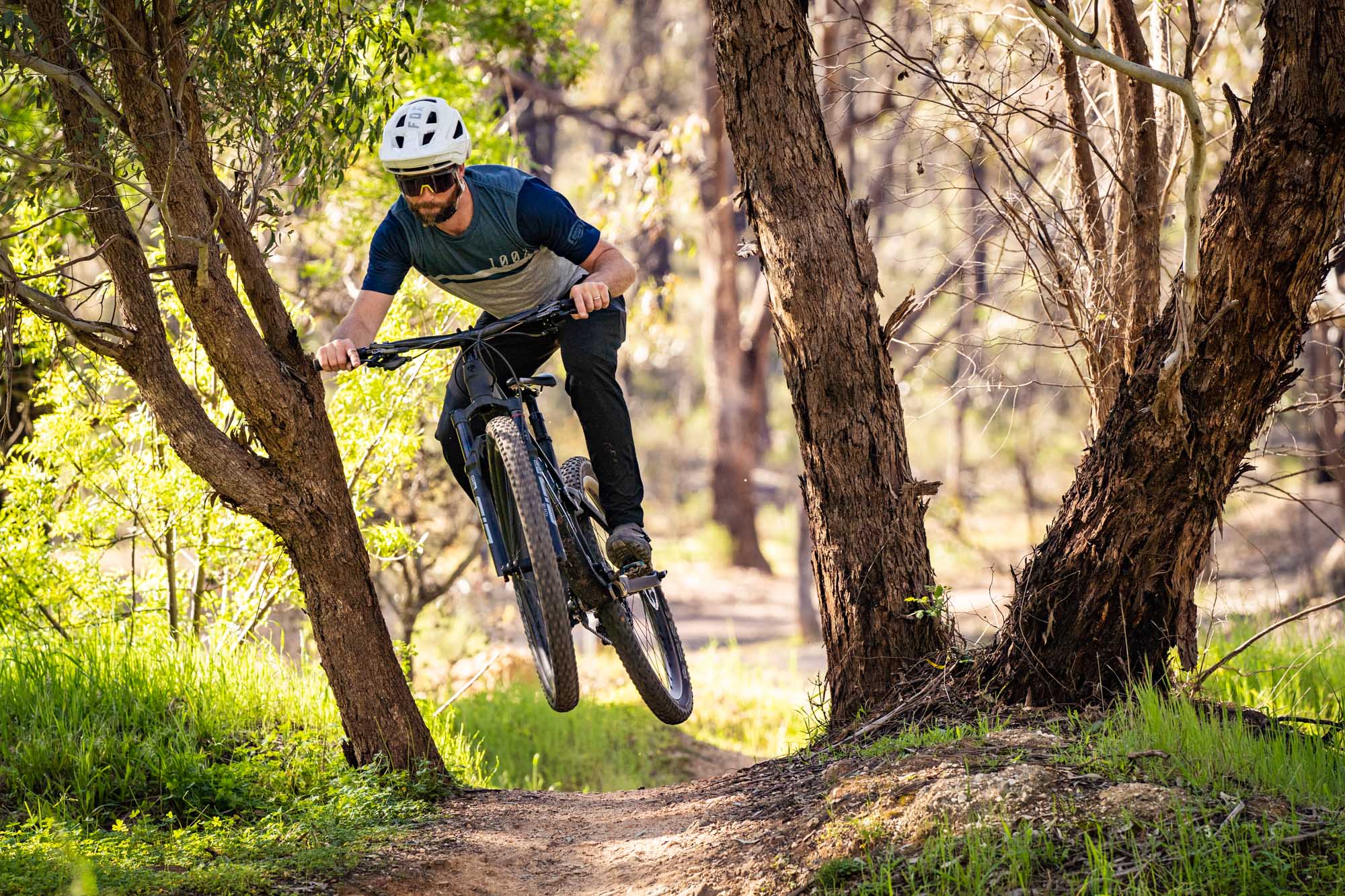
What does the Trek Top Fuel do well?
From the very first ride the new Trek Top Fuel proved to be easy to get used to, with no quirks to the fit, handling or suspension.
The proportions are significantly broader compared to the outgoing Top Fuel, with the front wheel sticking out much further ahead of the rider. Despite the long reach however, the effective top tube length is basically identical to its predecessor, so the overall cockpit length remains the same.
The steeper seat angle is noticeable though, providing an improved climbing position with your hips placed further over the bottom bracket. As a result, less bum-shuffling is required on stem-chewing ascents.
Pedalling performance is also superb. Despite its burlier exterior, Trek is still prioritising pedal efficiency with the Top Fuel, with the main pivot positioned high and quite far forward of the bottom bracket. Anti-squat is claimed to hover around the 100% mark, and indeed the rear suspension clenches tightly under chain torque, propelling the whole bike forward with minimal energy loss.
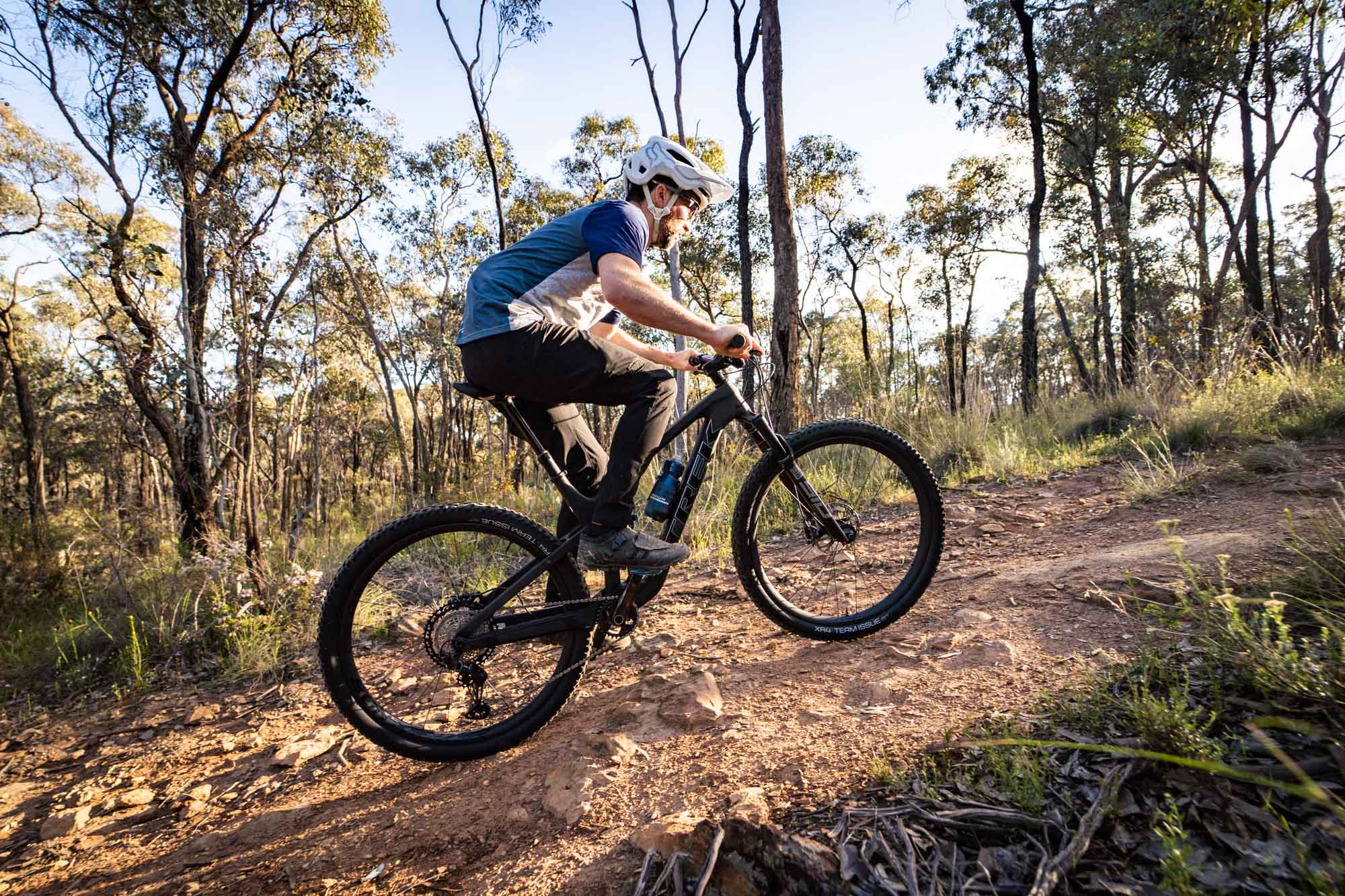
Active suspension performance
Despite the trunnion bearing mount and the longer shock stroke, the rear suspension doesn’t feel radically plusher than its predecessor, which already offered great performance. It is noticeably more supportive though, particularly when absorbing square-edge hits at speed, and when returning to earth after boosting off a lip on the trail.
It’s worth noting here that many bikes in the 100-130mm travel bracket make use of a carbon flex-stay design, including the Canyon Lux Trail, Merida Ninety-Six, and Specialized Stumpjumper. As well as being simpler, flex-stay designs are typically lighter too.

In comparison, the Top Fuel sticks with a genuine four-bar platform based around the ABP suspension design. Trek claims the ABP pivot helps to isolate braking forces from the suspension, and indeed it does result in less skipping and skidding when you’re on the brakes on loose, rocky descents.
With all the pivot points rolling on steel ball bearings, the suspension is more active and possesses a more consistent feel to both compression and rebound damping when compared to a flex-stay design. Yes it’s heavier, but the Top Fuel offers notably more active suspension performance, with excellent traction on loose climbs and better reactivity across chattery rock gardens. It’s very impressive for a 120mm travel bike.

Look out Fuel EX!
The geometry is also brilliant, and the handling really sets it apart from the outgoing Top Fuel.
Cornering performance has improved, with more grip courtesy of the longer front end and those XR4 tyres. These are great all-rounders, with a supple casing and surprisingly decent rolling speed given their size and tread pattern.

The new Top Fuel is also much more composed on rough and fast descents. Thanks to the longer reach and slacker head angle, the overall wheelbase length has grown by almost 40mm. That’s huge, and it offers a vastly more planted feel at speed. Along with the big tyres and active suspension, this really is a solid little trail bike.
In fact, the geometry updates kind of make the Fuel EX look a little outdated. The two bikes now share the same head angle, and the Top Fuel has a 10mm longer reach and a steeper seat angle. The front end is quite a bit higher on the Fuel EX though, and that does inspire more confidence on really steep descents.
As mentioned earlier though, it’s possible to fit a 130mm fork to the Top Fuel, which would lift the front end and actually make it slacker than the Fuel EX. Indeed there’s now quite a bit of overlap between the two platforms, leaving us to ponder what could be in store for the next generation Fuel EX.

What does it struggle with?
You’ve likely gathered that the new Trek Top Fuel is more of a muscly trail ripper than a spindly XC featherweight. While it may carry over the name, it’s evolved into quite a different bike compared to its racier ancestors.
The lack of a remote lockout results in a much cleaner cockpit, and we like how it signals the Top Fuel’s commitment to its trail riding intentions. However, it may disappoint those riders and racers who prefer having an instantaneous sprint button at their fingertips.
Indeed with all the updates, and the fact that the new Top Fuel has double the travel of the Supercaliber, there is now an even bigger gap between these two bikes. Riders who are still interested in some part-time XC racing, but aren’t sold on the Supercaliber’s sharp geometry and proprietary IsoStrut suspension design, may be turned off by the Top Fuel’s new attitude.
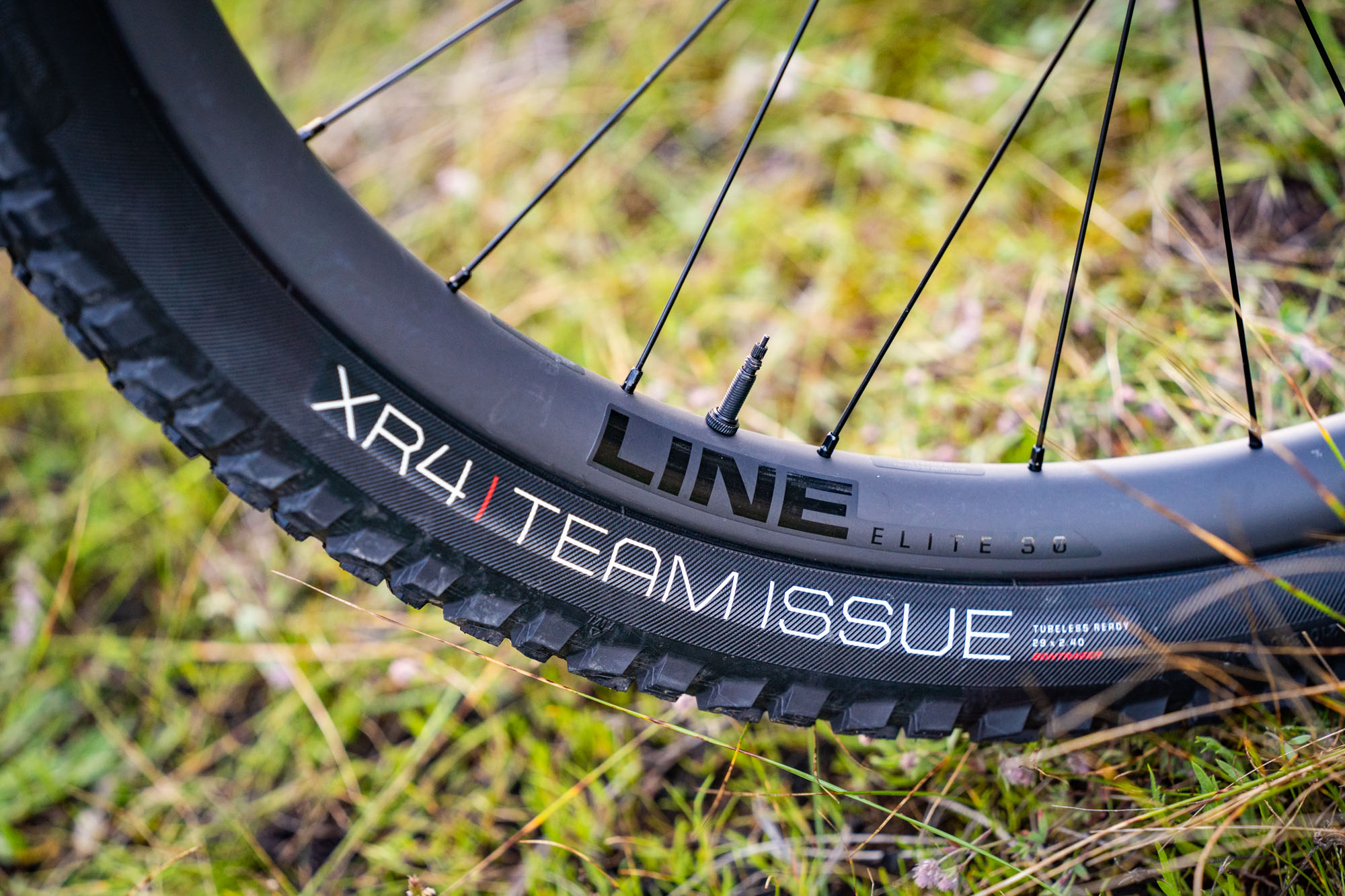
Of course you could easily inject some speed with some lighter and faster-rolling tyres, like Bontrager’s XR2. There’s also around half a kilo to be saved in the wheelset, which would make a significant difference to the Top Fuel’s acceleration and climbing enthusiasm.
You could also flip the Mino Link into the High position to steepen the angles. In that guise, with lighter wheels and faster tyres, the Top Fuel would make for a comfortable and confidence-inspiring option for those wanting to sign up for the odd endurance race or multi-day event. If you’re serious about your XC racing though, this is not the bike for you – you’ll be wanting to look at the stupendously efficient Supercaliber for such endeavours.
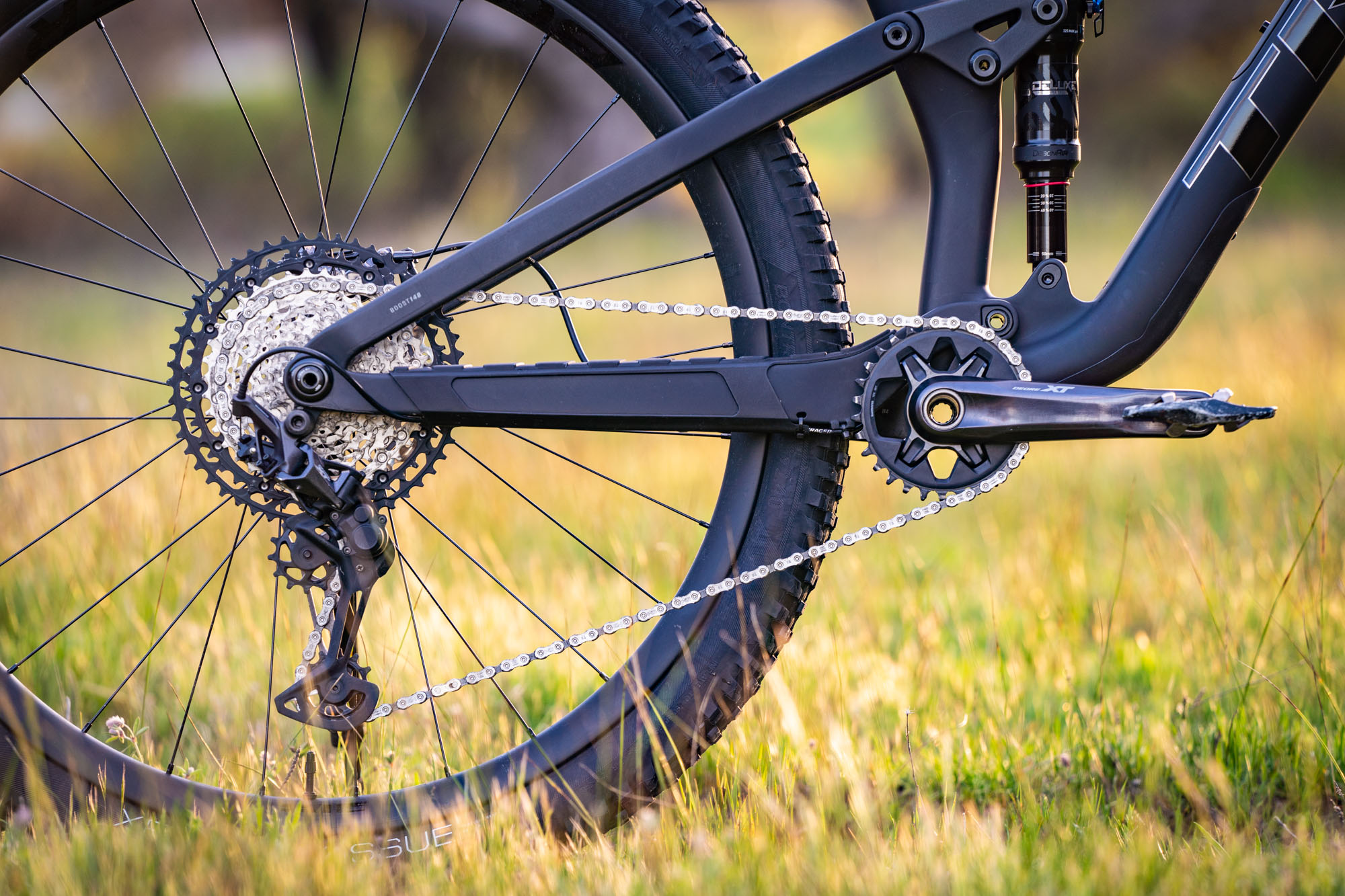
Component highs & lows
The 2022 Trek Fuel 9.8 XT is a solid package out of the box, especially when you consider it comes in $1,600 cheaper than the 2021 model. And that’s with a pretty much identical build kit. How has a new bike gotten cheaper in the midst of a global pandemic and industry-wide component shortages? Heck knows!
There’s not a lot to be said about the Shimano XT groupset – it works, it’s solid, and it’s easy to tune. The I-Spec mounts offer plenty of adjustability for getting the brake and shift levers into the right spot, and the integrated dropper lever is a nice touch too.
The RockShox suspension isn’t quite as sensitive as the Fox equivalent, particularly the SID Select+ fork, which felt a little stickier than we expected. Otherwise the fork and shock perform well, and the ease of setup is great.

The Bontrager dropper post works fine, but the action is sluggish compared to some of its competitors. And while the carbon handlebars offer a nice profile, having spent a lot of time on OneUp handlebars lately, the Bontrager Line Pro feels considerably harsher in comparison.
We’ve had excellent long-term experience with Bontrager’s latest Line Pro & Line Elite carbon wheels , which feature thick carbon beads that are designed to increase impact strength while also reducing the chance of pinch-flats. They’re totally solid and come with an excellent crash-replacement guarantee, while the buzzy 108pt engagement freehub delivers rapid pickup at the pedals. As mentioned earlier though, they are heavy, providing an opportunity to drop significant weight with a wheel upgrade.
Otherwise we’ve been impressed with the frame finish so far. The Mino Link is simple and effective, the Knock Block is totally unnoticeable on the trail, and we’re big fans of the built-in storage from the Burrito Box. Or is it the Kebab Cave? Maybe a Sausage Roll Hole? Sushi Shaft? Cannoli Cavity? Hot Dog Hollow? Spring Roll Room?
Alright, alright! We’ll show ourselves the door…the door that leads into the Spring Roll Room – ha!

Flow’s Verdict
Tying together a whole suite of updates to the frame and suspension design, there are no doubts that the new Trek Top Fuel is a more capable bike than its predecessor. It’s still very efficient, but having adopted a more progressive approach to its geometry, it delivers a significant improvement in stability. Along with the active ABP suspension design and chunky tyres, there’s an exceptional amount of grip and support on offer for a 120mm travel bike.
With all those changes, the Top Fuel moves even further away from the Supercaliber. And for some riders, that gap will be a little too wide.
Trek seems happy to have a clear delineation between the two platforms though. This differs from some other brands that utilise a single frame, and simply up-fork and up-shock it to create a slightly longer travel bike (like the Specialized Epic EVO and Orbea Oiz TR). The Top Fuel is not one of those bikes.
Instead of being a long-legged Supercaliber, it’s really a shrunken-down Fuel EX, albeit one with more contemporary geometry. And having ridden both bikes, unless you really need the extra travel of the Fuel EX, this is arguably the better option.
Sure it may have put off the weight-weenies and lockout-lovers, but there’s no denying that the Top Fuel has broadened its appeal to an even wider range of riders, and we reckon it’s more fun as a result.

2022 Trek Top Fuel 9.9 XTR
- Fork | Fox 34 Step-Cast, Factory Series, FIT4 Damper, 44mm Offset, 120mm Travel
- Shock | Fox Float DPS, Factory Series, 185x50mm
- Wheels | Bontrager Line Pro 30, OCLV Carbon Rims, 29mm Inner Width
- Drivetrain | Shimano XTR 1×12 w/e*thirteen TRS Race Carbon 30T Crankset & 10-51T Cassette
- Brakes | Shimano XTR Race 2-Piston w/Ice Tech Rotors
- Bar | Bontrager RSL Integrated, OCLV Carbon, 27.5mm Rise, 820mm Width
- Stem | Bontrager RSL Integrated, OCLV Carbon, Length: 35mm (S), 45mm (M-XL)
- Saddle | Bontrager Arvada Pro, Carbon Rails
- RRP | $14,199 AUD

2022 Trek Top Fuel 9.7
- Fork | Fox Rhythm 34, GRIP Damper, 44mm Offset, 120mm Travel
- Shock | Fox Float DPS, Performance Series, 185x50mm
- Wheels | Bontrager Line Comp 30, Alloy Rims, 29mm Inner Width
- Drivetrain | Shimano SLX/XT 1×12 w/Deore 30T Crankset & 10-51T Cassette
- Brakes | Shimano SLX 4-Piston
- Bar | Bontrager Line, 27.5mm Rise, Width: 750mm (S), 780mm (M-XL)
- Stem | Bontrager Elite, 45mm Length
- Seatpost | TranzX Dropper, 34.9mm Diameter, Travel: 100mm (S), 150mm (M-M/L), 170mm (L), 200mm (XL)
- Saddle | Bontrager Arvada, Steel Rails
- RRP | $6,299 AUD

2022 Trek Top Fuel 8
- Frame | Alpha Platinum Alloy, ABP Suspension Design, 120mm Travel
- Fork | RockShox SID, Rush RL Damper, 44mm Offset, 120mm Travel
- Brakes | Shimano Deore 4-Piston
- RRP | $5,299 AUD

2022 Trek Top Fuel 5
- Fork | RockShox 35 Silver RL, Motion Control Damper, 44mm Offset, 120mm Travel
- Shock | X-Fusion Pro 2, 185x50mm
- Wheels | Bontrager Alloy Hubs & Alex MD35 Rims
- Drivetrain | Shimano Deore 1×12 w/Deore 30T Crankset & 10-51T Cassette
- Brakes | Shimano MT200 2-Piston
- Bar | Bontrager Comp, 15mm Rise, 750mm Width
- Stem | Bontrager Rhythm Comp, 50mm Length
- Seatpost | TranzX Dropper, 34.9mm Diameter, Travel: 100mm (S), 150mm (M-M/L), 170mm (L-XL)
- RRP | $3,499 AUD
- Submit for Review
- Terms & Conditions
Enjoy reading this?
Get similar articles delivered directly to your inbox

Based on frame geometry and build specs.
A bike with lower gearing will be easier to ride up steep hills, while a higher top end means it will pedal faster down hills.
2022 BLUR R / TR / Carbon C / 29
2023 Fuel EX 8 Gen 6
2023 Top Fuel 9.8 XT
(descending)
Based on build material and quality level of the frame, fork, wheelset, groupset, suspension system, and more.

- Forum Listing
- Marketplace
- Advanced Search
- Community Help Section
- Archived Discussions
Santa Cruz vs Trek
- Add to quote
- I'm 6' 3" / 210 lbs, and will be primarily riding in Northern NJ
- My preferences are in the trail/all-mountain category; I like to ride mostly rolling single track, but with some technical bits, bumpy climbs and moderately challenging descents thrown in as well
- My level of skill and fitness is in the intermediate realm, and my goal is to have fun on bike well-suited to the type of riding I most enjoy (as opposed to aspiring to compete, etc.)
- I like a somewhat upright riding position (bars a little higher than the saddle) to minimize back/neck strain
Up to last week I too lived in northern NJ. My usual rides were Mahlon Dickerson, Allumuchy, Lewis Morris, Kittatinny, etc. By northern NJ I'm guessing you are familiar with these areas. First off, if you can find a shop in our area to demo a Santa Cruz, I'd love to find out about it because as far as I can see, the brand is not well represented in the NE. I can not say how the current VPP suspension rides in our conditions but I did ride the Treks you mentioned and an older VPP which I'll get to. Two months ago I went to a Trek demo at Marty's in Randolph. I'm coming from a 26" Trance and am in the market for a new bike. My first ride was the Remedy 9 - 29". The demo was on dirt and semi-technical trails and I was very impressed with the over all ride of the bike. From the 29" I went to a 650b Remedy and was less then blown away by the current fan favorite. To me, the 650b felt so much like my 26" Trance that there was no real reason to switch. It did not split the difference between 26" & 29" but that has been pointed out by so many its old news by now. Finally I tried a 29" Fuel EX. I liked it better than the 650b Remedy but not as much as the 29" Remedy which, for the type of riding I did and will do again next year, was more the bike I was looking for. The only time I've ridden a VPP was an original 26" Blur in Norcal about six years ago. I liked the bike but the trails were much easier than what we face. I'm not saying they weren't fun because they were but I would have to put the stuff I rode in the category of Six Mile Run but with looong climbs. Little to no rocks or roots. I've heard the VPP is similar to the Giant Maestro suspension on the Giant and the Blur did feel like the Trance on the trails I rode but not being faced with the technical stuff we take for granted, it is hard to make an accurate comparison. So, anyway, for Mahlon Dickerson, which was and will be my home park again, the Remedy seemed the best option. Like you, I do not claim to be an expert, just a solid intermediate long past racing. I hope this is some help. You didn't say where you lived in NJ but Marty's Randolph has lots of Trek demos and the cost of the demo goes towards the price of a bike if you decide to buy there. When I move back to north Jersey next year, I plan to rent the demos before I buy.
Thanks for the thoughtful replies! This is a great forum; I can see spending a lot of time here... I'm in Hackettstown, NJ, so right next door to Steven's, Alamuchy and Deer Park. Also not far from Kitatinny and a couple others. So far, since moving here and getting back on a bike, I've tried Deer Park and Six Mile; of the two, I enjoyed Six Mile more, but I think I'd most prefer something a little more interesting (challenging technically?) than Six Mile. As far as geometry, I definitely want something more on the upright side (unfortunately, it's hard to get a real sense of this when demo'ing bikes because there are no XLs to be found, so none of them are a true fit). Pedaling efficiency and nimble handing are a concern, but I won't need an XC race machine... assuming it's fairly good in these respects, then a compliant ride would be my priority. For those who've rode the Remedy 29, does it climb and corner well enough to enjoy tight, technical single track with climbs and descents? Would it be comparable than the Fuel EX to a Tall Boy LT for this type of terrain? As for the Fuel EX, I'm starting to think it leans more toward XC than AM. From a geometry and ride compliance perspective, maybe I'm better off on a longer travel bike... As long as it's not too cumbersome climbing and navigating tight single track!
Again, you need to ride them. I don't know if you mean slack angles or the stem and top tube when you say upright. My observation is the XC or racer geometry is less adjustment or thought for getting traction. The slack or AM has you covered better for steep, rough and very fast stuff. My preference was (is) for the more slack and shorter chain stay Remedy 29 over Fuel 29 but as far as fun 29 bikes Kona's geometry is even more playful making you forget that you're diving a two wheel tank and able to pop the front and land more like a dirt jumper. The can pump it nature I want may not be what you want but I also think that's a bike skill that way too many riders don't know or forget. My super easy to pump and launch 29r requires more adjustment for climbing. Nothing against 29 (I love mine) but the 650B Remedy was so nice and fun compared to the two 29 Remedy and Fuel that I'm not buying a bike until I can try the 650B Fuel and their new shock product. That new shock because the low speed platform might help the 29 bikes some pump and pop the front up ability. I have no experience with the tall boy but at times like the way VPP stiffens up under power. OTOH it seems like Trek figured out how to stay plush and not dig or sag into the travel like my Specialized did to get super traction. Have fun shopping and make the effort or expense that let's you try other bikes on trails vs bike shop parking lots.
I can only speak from my demo on Treks but I felt the Remedy 29 climbed and cornered very well. Next year when I am back in north Jersey, I want to rent a demo from Marty's and spend a day at Mahlon Dickerson which is not as technical as Allamuchy but close in sections. Again, from my limited experience on the Fuel and Remedy, I felt the Remedy 29" made more sense for the type of trails we have. Another 20 mm of travel is a nice thing to have with our abundance of rocks and, unless I was in an xc race, the bike didn't feel slower than the Fuel but I have no scientific way to quantify the feeling. This was the first time I even road a Trek of any kind but I had no complaints with the way they handled and the 29" did climb very well compared to the 650b. In the end, what I may have gotten from my day of demos was that the 650b felt so much like my 26" Trance that there was no reason to spend the money. The 29" was a big enough jump that I could feel a difference. Another unscientific observation, for what its worth, is that when I used to ride with a buddy on a 29", my turns were almost always inside of his. I could tell since I was usually the one following. Just because my turns were inside of his does not mean he was having any difficulties but it is a difference I noted. We rode the same places in north Jersey and neither of us had any problems that could be attributed to anything other than lack of skill and old age. From my many years of experience riding north Jersey, if you like Six Mile or Deer Park, the Fuel would be an excellent choice. Since I have to ride more technical parks closer to home, the Remedy presents "me" more options. Right now I have an early 26" Trance with only 100 mm rear and a RS Revelation fork cranked out to 130 mm front. I'm sure a much better rider could handle most anything in north Jersey on that set up. Heck, more aggressive tires may be more important than an extra 20 mm of travel but I can't quantify that statement. Anyway, its time to finish breakfast and leave the island and head to Morris County to take care of some business. As nice as it is to wake up and have the ocean a hundred yards away, I already miss the riding. I'll be interested in what you end up buying and your experience with it.
From what I've gathered so far, it does seem as though the Trek ABP pedal bobs less than the Stumpy FSR system. Also, the Specialized brain system (on the Stumpy Elite that I did a ten mile trail ride demo on) was not too impressive... it seemed like it transmitted initial chop before the brain reacted and opened the valve to allow damping. (And actually I'm a little concerned that the way the 2015 Trek Penske/ABP system is described to function, that it may suffer from similar shortcomings.) I'm kinda leaning toward the Trek system at this point, but I'm still not sure whether I'd be happier on their 120mm XC/trail bike (Fuel EX) or their 140mm trail/AM bike (Remedy). Hopefully I can demo both for a good trail ride to get a better sense of which is the preferable platform.
Trek Fuel EX is a great build for the price. I haven't personally ridden one, but I have read some reviews on it saying that it is a good all-round bike. If you can look at other brands, I highly recommend looking at Rocky Mountain. The Instinct is a great climbing bike even with 130mm of travel.
I was in the same boat and bought a Fuel Ex 9 29er. It was a great choice for me. I primarily ride rocky, steep, and tight singletrack and the Fuel is great for all of that. It is a phenomenal climbing bike in technical terrain, and very confident going down once I changed up the cockpit (short stem/wide bars). The Remedy certainly is a better descender, but the Fuel does not handicap you going down. If I was choosing between the two again, I would make the decision based on how much you ride larger drops and mid-size jumps? How often will you go to bike parks? If you ride drops and jumps a lot, definitely go Remedy. If you don't, and your primary purpose is up and down singletrack, either bike is a solid choice, but I would lean to the Fuel....but I would ride them both again.
I love my Remedy. I can fly on the downhills and rail corners like crazy on it. Awesome suspension and it always gives me a fun ride. I know they might be coming out with a carbon version soon so if you can afford it I would wait. As much as I love it the bike is still pretty heavy and that makes climbing up the steep, rocky trails by me a bit tough sometimes. All and all a great bike though. Easy to jump and the wide bars don't hurt. I just want a shorter stem for mine
- ?
- 15.5M posts
- 516K members
Top Contributors this Month

COMMENTS
The Santa Cruz BLUR S / Carbon C / 29, Trek Top Fuel 9.7, and Trek Top Fuel 9.8 XT are all 29″ carbon frame full suspension mountain bikes. The BLUR S / Carbon C / 29 has better components and higher gearing, while the Top Fuel 9.8 XT has carbon 29″ carbon wheels and a better fork.
For instance, compare the Top Fuel in this field test to the Top Fuel 9.7 ($4300 US) or the Top Fuel 8 (alum. version). Compare the RM Element to the Element Carbon 30 ($4300 US) or the Element 50 ...
While the Trek Top Fuel used to be a lean, mean, cross-country fighting machine, the middle-aged spread has left it sagging a little on the scales. ... It's much stiffer than the Transition Spur, and not as capable as the Santa Cruz Tallboy or Yeti SB120, so in some ways it's a bit of an anomaly. But it's also a great-looking bike, feels ...
The blur TR or XC are actual XC bikes that compromise descending speed. The blur doesn't belong in this test is the greater point im trying to make. As well as the epic evo doesn't compare to the ...
Field Test Review: 2022 Trek Top Fuel - Same Name, Different Bike. Dec 3, 2021 . ... but both were pipped by the ground-hugging missile that is the Santa Cruz Blur TR. For a bike that is so ...
Verdict. Trek's Top Fuel 8 is a brilliant example of just how good short-travel suspension can feel, and less stroke always means a more responsive, visceral ride than a leggier bike. The geometry and proper trail tires really let you exploit the hooligan that's hiding in the frame along with your pump, tool and spare tube too.
Best downcountry mountain bikes of 2024 | Top-rated downcountry MTBs and buyer's guide | BikeRadar.
Hi everyone! I'm in the process of replacing my bike and I am completely stuck with a decision between the Trek Top Fuel 9.8 and the Santa Cruz Blur S build. They are very similarly priced, weigh almost exactly the same (websites) and have very similar components. The Trek has carbon wheels, handlebar and seat-post, but an alu chainstay.
This Trek Top Fuel review has it all: Speed, sustainability, shifting mindsets, and thoughts on the new breed of short travel trail bikes. ... Once again, neither one fits that category definition and, to their credit, Santa Cruz does not use the term (btw Blur is definitely a XC race bike even in TR form, and Tallboy is a trail bike - weighs ...
Trek Top Fuel 9.8 XT - 12.88kg. Giant Trance Advamced Pro 29 1 - 13.38kg. Trek claims a carbon Top Fuel frame weighs 2.7kg including the rear shock, which puts it on the heavier side of things for a 120mm travel bike. The alloy frame is purportedly a whole kilo heavier again, with a claimed weight of 3.74kg.
The Santa Cruz BLUR R / TR / Carbon C / 29, Trek Fuel EX 8 Gen 6, and Trek Top Fuel 9.8 XT are all full suspension mountain bikes. The BLUR R / TR / Carbon C / 29 has 29″ aluminum wheels and higher gearing; the Fuel EX 8 Gen 6 has an aluminum frame, 27.5″ / 29″ aluminum wheels, and more travel; and the Top Fuel 9.8 XT has carbon 29″ carbon wheels, better components, and a better fork.
The Trek Fuel EX 9.8 is the best mid-travel bike in our test, with well-rounded performance and capabilities beyond its travel class. The Specialized Fuse 29 was easily the best all-around trail riding hardtail we've tested, and those seeking a great value should be sure to check out the affordable Polygon Siskiu T8 .
Trek Fuel EX-e vs Specialized Levo SL vs. Santa Cruz Blur XC climb speed test with constant rider power. ... Trek just introduced the Fuel EXe with 140/150mm of travel with a revolutionary motor made by TQ. This motor is small and quiet and it sported a more powerful motor with 50nm of torque and 300 watts of output. ... Top Contributors this ...
We are checking out the Santa Cruz Blur TR, this is part of the ever popular growing down country by category where the goal is to be as fast as possible up ...
Santa Cruz HIGHTOWER R vs Trek Top Fuel 9.7. Faced with the more expensive Santa Cruz HIGHTOWER R, my heart was hard to choose. The same great 1×12 speed drivetrain, the same range of options with more power, and the simpler, more novice-friendly, classic 29″ wheels. The rolling efficiency or obstacle crushing and even steering agility are ...
From what I've read, Trek's ABP suspension seems to be the more plush of the two (although I didn't notice a significant difference after a few short test rides at a couple LBSs). But at the same time, the Fuel EX in particular has less suspension travel (120/120mm, vs 140/140 on the Remedy and 135/140 on the Santa Cruz), so maybe the VPP Santa ...
#santacruzbicycles #santacruzblur @santacruzbicycles28412023 Santa Cruz Blur TR S buildhttps://www.santacruzbicycles.com/en-US/bikes/blurJoin me on my journe...
Trek Top Fuelhttps://www.trekbikes.com/us/en_US/bikes/mountain-bikes/cross-country-mountain-bikes/top-fuel/top-fuel-8/p/35072/?colorCode=redIbis Ripley https...